今天聊聊Mybatis源码,本博客是以 mybatis-3.5.6版本为例讲解。众所周知,MyBatis是一个ORM框架,用于操作数据库,给我们开发带来了很大的便利。它可以单独使用,也可以与Spring框架整合使用。目前主流的当然是和Spring框架整合,将Mybatis的bean交由Spring管理,可以很方便的使用Spring的事务。可能现在很多公司会使用Mybatis-Plus或者TK-Mybatis,在我看来,这两种框架是对Mybatis框架的增强,如果了解Mybatis的底层,再去看那两个框架的底层原理,想必也不是一件难事!话说回来,由于是跟Spring框架做整合,所以需要对Spring框架比较熟悉,Spring框架原理的讲解,请移步到这里:Spring源码深度解析(上)。
话不多说,开始今天的正题。首先,我们要引入相关依赖:
<?xml version="1.0" encoding="UTF-8"?>
<project xmlns="http://maven.apache.org/POM/4.0.0"
xmlns:xsi="http://www.w3.org/2001/XMLSchema-instance"
xsi:schemaLocation="http://maven.apache.org/POM/4.0.0 http://maven.apache.org/xsd/maven-4.0.0.xsd">
<parent>
<artifactId>mybatis_parent</artifactId>
<groupId>com.szl</groupId>
<version>1.0-SNAPSHOT</version>
</parent>
<modelVersion>4.0.0</modelVersion>
<artifactId>mybatis_test</artifactId>
<properties>
<maven.compiler.source>8</maven.compiler.source>
<maven.compiler.target>8</maven.compiler.target>
</properties>
<dependencies>
<dependency>
<groupId>org.mybatis</groupId>
<artifactId>mybatis</artifactId>
<version>3.5.6</version>
</dependency>
<dependency>
<groupId>org.mybatis</groupId>
<artifactId>mybatis-spring</artifactId>
<version>2.0.6</version>
</dependency>
<dependency>
<groupId>org.springframework</groupId>
<artifactId>spring-context</artifactId>
<version>5.1.18.RELEASE</version>
</dependency>
<dependency>
<groupId>org.springframework</groupId>
<artifactId>spring-jdbc</artifactId>
<version>5.1.18.RELEASE</version>
</dependency>
<dependency>
<groupId>com.github.pagehelper</groupId>
<artifactId>pagehelper</artifactId>
<version>5.2.0</version>
</dependency>
<dependency>
<groupId>org.projectlombok</groupId>
<artifactId>lombok</artifactId>
<version>1.18.8</version>
</dependency>
<dependency>
<groupId>com.alibaba</groupId>
<artifactId>druid</artifactId>
<version>1.1.9</version>
</dependency>
<dependency>
<groupId>javax.persistence</groupId>
<artifactId>persistence-api</artifactId>
<version>1.0</version>
</dependency>
<dependency>
<groupId>org.javassist</groupId>
<artifactId>javassist</artifactId>
<version>3.18.2-GA</version>
</dependency>
<dependency>
<groupId>mysql</groupId>
<artifactId>mysql-connector-java</artifactId>
<version>8.0.23</version>
</dependency>
</dependencies>
</project>然后创建一个配置类,名为 DataSourceConfiguration,代码如下:
package com.szl.config;
import com.alibaba.druid.pool.DruidDataSource;
import com.github.pagehelper.PageInterceptor;
import org.apache.ibatis.plugin.Interceptor;
import org.mybatis.spring.SqlSessionFactoryBean;
import org.springframework.beans.factory.annotation.Qualifier;
import org.springframework.context.annotation.Bean;
import org.springframework.context.annotation.Configuration;
import org.springframework.context.annotation.Primary;
import org.springframework.jdbc.datasource.DataSourceTransactionManager;
import org.springframework.transaction.PlatformTransactionManager;
import org.springframework.transaction.annotation.TransactionManagementConfigurer;
import javax.sql.DataSource;
/**
* @ClassName DataSourceConfiguration.java
* @Author lizhao
* @Description TODO
* @Version 1.0
* @CreateTime 2021年09月17日 23:06:00
*/
@Configuration
public class DataSourceConfiguration {
@Primary
@Bean(name = "dataSource")
public DataSource dataSource() throws Exception {
DruidDataSource druidDataSource = new DruidDataSource();
druidDataSource.setUsername("root");
druidDataSource.setPassword("123456");
druidDataSource.setUrl("jdbc:mysql://127.0.0.1:3306/test?serverTimezone=UTC" +
"&characterEncoding=utf8&useUnicode=true&useSSL=false&allowPublicKeyRetrieval=true");
druidDataSource.setDriverClassName("com.mysql.cj.jdbc.Driver");
return druidDataSource;
}
@Bean(name = "pageInterceptor")
public Interceptor interceptor() {
PageInterceptor pageInterceptor = new PageInterceptor();
return pageInterceptor;
}
@Bean
public SqlSessionFactoryBean sqlSessionFactoryBean(@Qualifier("dataSource") DataSource dataSource,
@Qualifier("pageInterceptor") Interceptor interceptor) {
SqlSessionFactoryBean sqlSessionFactoryBean = new SqlSessionFactoryBean();
sqlSessionFactoryBean.setPlugins(interceptor);
sqlSessionFactoryBean.setDataSource(dataSource);
return sqlSessionFactoryBean;
}
@Bean
public TransactionManagementConfigurer transactionManagementConfigurer(@Qualifier("dataSource") DataSource dataSource) {
TransactionManagementConfigurer transactionManagementConfigurer = new TransactionManagementConfigurer() {
@Override
public PlatformTransactionManager annotationDrivenTransactionManager() {
return new DataSourceTransactionManager(dataSource);
}
};
return transactionManagementConfigurer;
}
}该配置类中,创建了一些bean:
① DataSource,用于连接数据库(这里使用的是Druid数据库连接池);
② PageInterceptor,拦截器插件,用于分页查询;
③ SqlSessionFactoryBean,跟Spring整合的关键,属于mybatis-spring-2.0.5.jar中的类;
④ TransactionManagementConfigurer,Spring框架事务相关。
然后创建了一个App类,可以认为它是程序入口,代码如下:
package com.szl;
import com.github.pagehelper.PageInfo;
import com.szl.pojo.PcMetaFlowStepDef;
import com.szl.service.PcMetaFlowStepDefService;
import org.apache.ibatis.logging.LogFactory;
import org.mybatis.spring.annotation.MapperScan;
import org.springframework.context.annotation.AnnotationConfigApplicationContext;
import org.springframework.context.annotation.ComponentScan;
import org.springframework.transaction.annotation.EnableTransactionManagement;
import org.springframework.transaction.support.TransactionSynchronizationManager;
/**
* @ClassName App.java
* @Author lizhao
* @Description TODO
* @Version 1.0
* @CreateTime 2021年09月19日 03:09:00
*/
@EnableTransactionManagement
@ComponentScan(basePackages = {"com.szl"})
@MapperScan(basePackages = "com.szl.mapper")
public class App {
private static final AnnotationConfigApplicationContext applicationContext;
static {
// 开启Mybatis日志控制台打印。
LogFactory.useStdOutLogging();
applicationContext = new AnnotationConfigApplicationContext(App.class);
}
public static void main(String[] args) {
update(1L, "测试...");
}
private static void update(Long id, String descr) {
TransactionSynchronizationManager.initSynchronization();
PcMetaFlowStepDefService pcMetaFlowStepDefService = applicationContext.getBean(PcMetaFlowStepDefService.class);
pcMetaFlowStepDefService.update(id, descr);
}
private static void findByPageTest() {
PcMetaFlowStepDefService pcMetaFlowStepDefService = applicationContext.getBean(PcMetaFlowStepDefService.class);
PageInfo<PcMetaFlowStepDef> pageInfo1 = pcMetaFlowStepDefService.findByPage(1, 10);
System.out.println(pageInfo1);
}
}
项目的层级结构为:
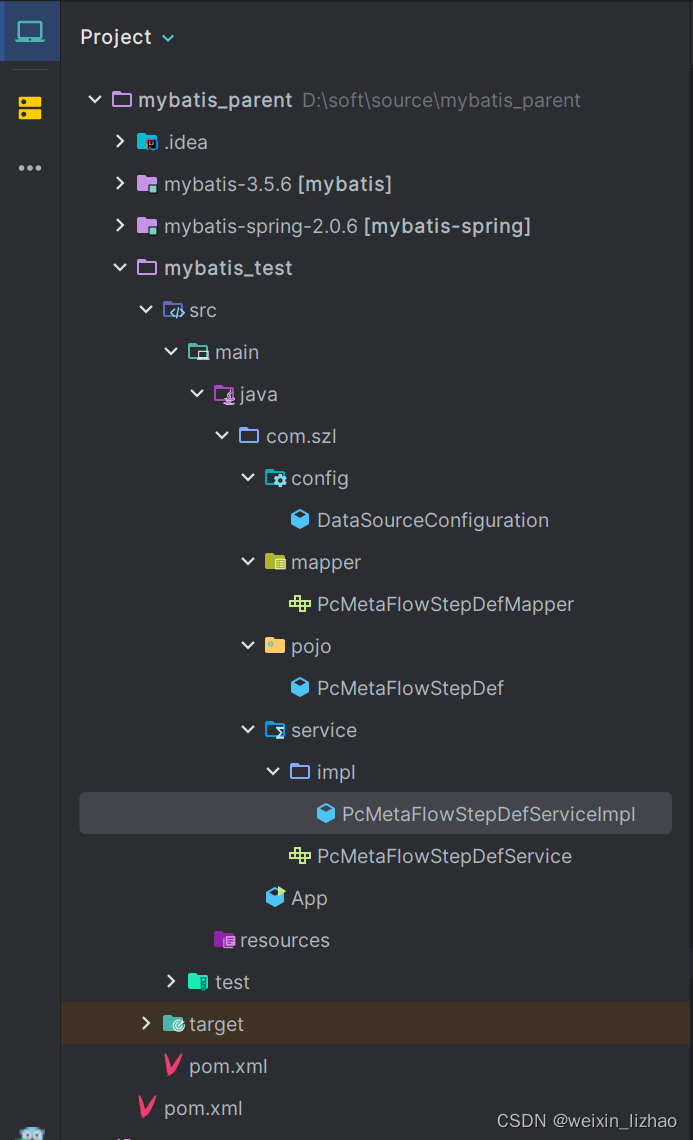
针对App类,该类被三个注解修饰,分别是:
① @EnableTransactionManagement,用于开启事务,它的作用是往Spring容器中注册了一个后置处理器,用于处理 @Transactional注解;
② @ComponentScan注解,用于包扫描;
③ @MapperScan注解,用于Mybatis的包扫描,因为涉及到接口的注册,对于Spring框架而言,接口是不会被放入Spring的IOC容器的。
这里,重点聊聊@MapperScan注解,代码如下:
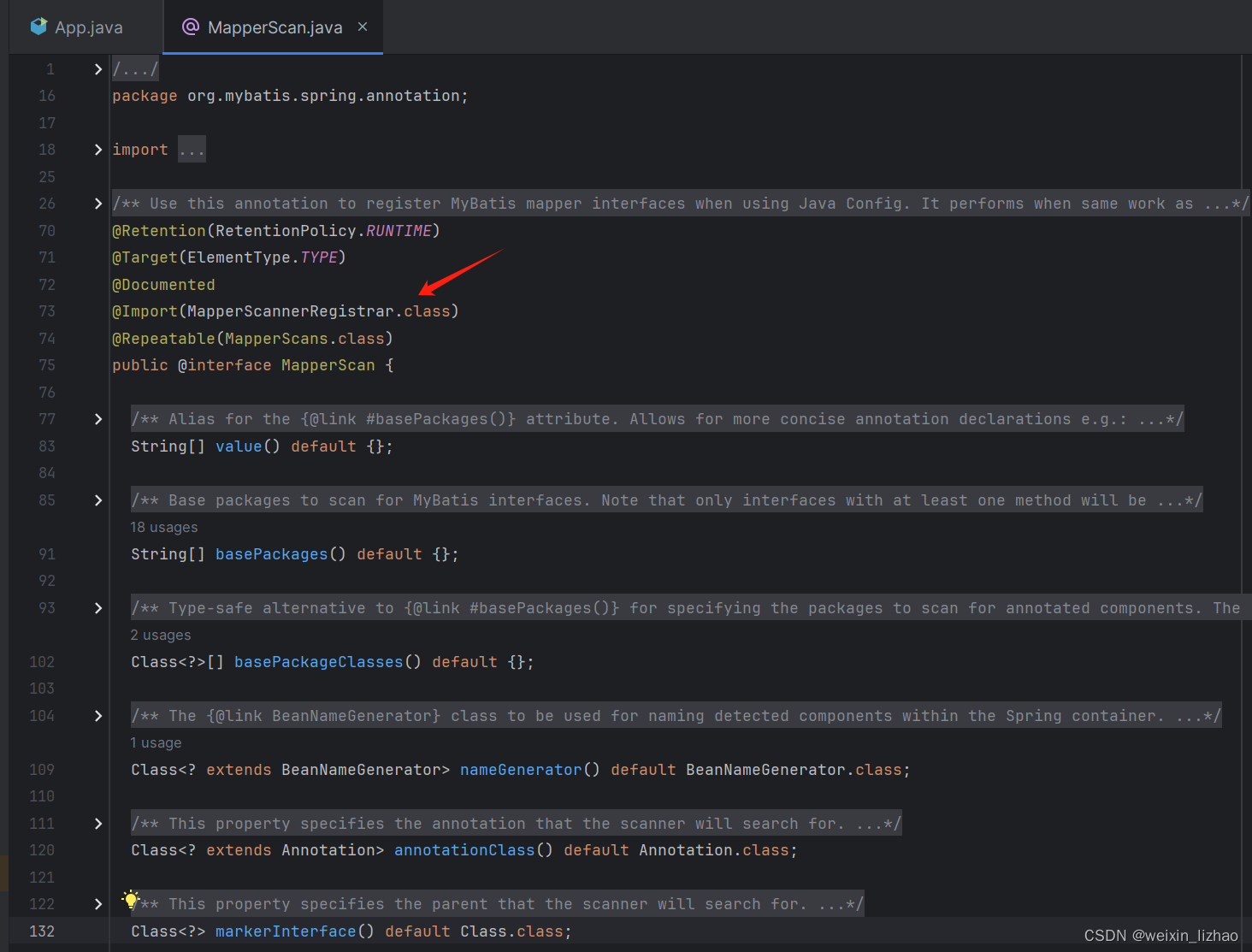
该注解可以设置很多参数,用到再讲,用得最多的是,String[] value()、String[] basePackages(),这两个参数是等价的,都是用于设置要扫描的包。当然,最核心的还是 @MapperScan注解上的@Import注解,对Spring熟悉的话,就知道这个注解会将MapperScannerRegistrar注册到Spring容器中。看看这个类,代码如下:
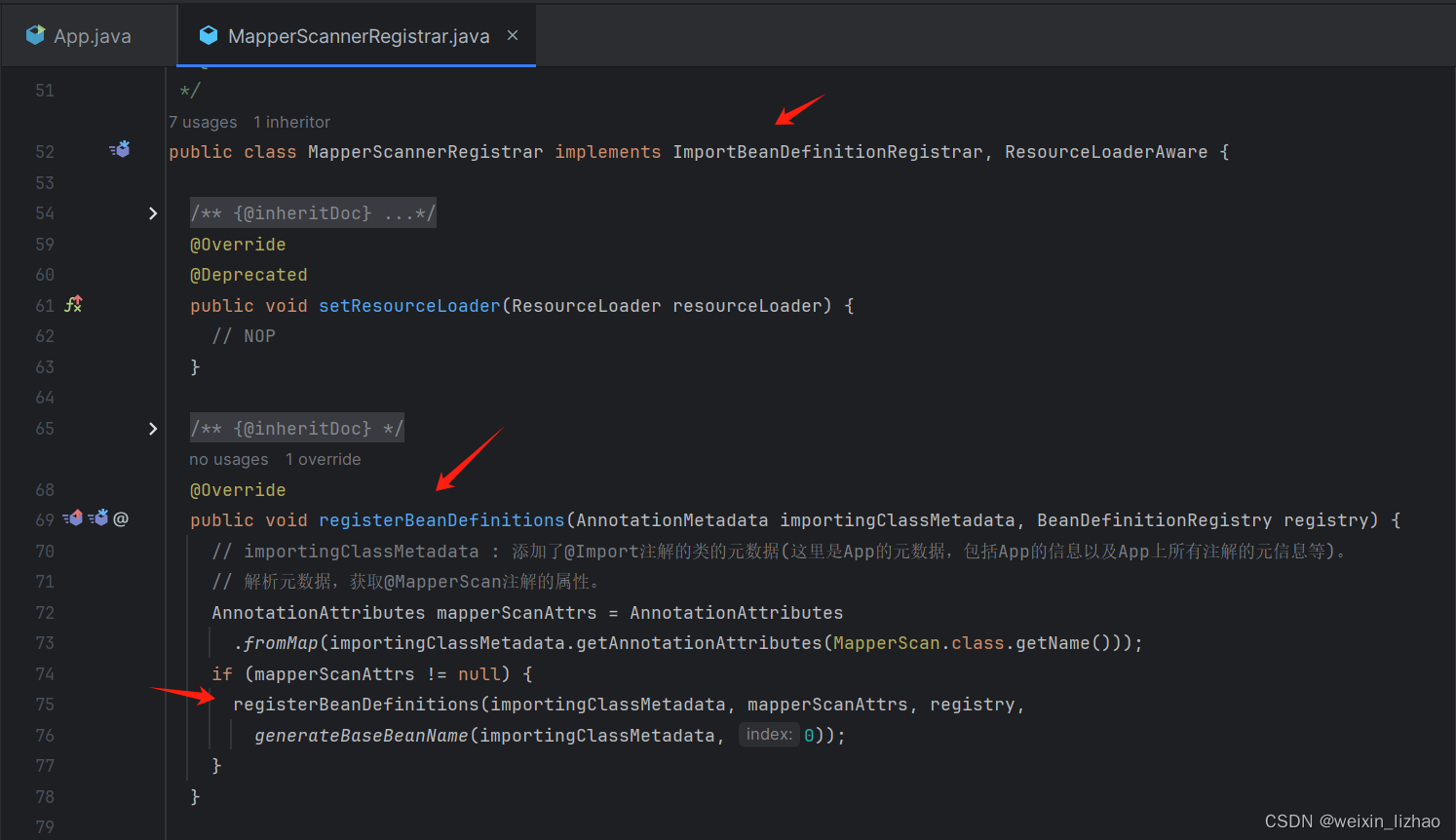
由于该类实现了ImportBeanDefinitionRegistrar,最终Spring会调用ImportBeanDefinitionRegistrar#registerBeanDefinitions()方法,在该方法中可以获取到@MapperScan注解上的相关信息,然后调用MapperScannerRegistrar#registerBeanDefinitions()方法,很明显该方法就是处理@MapperScan注解,看看该方法,代码如下:
void registerBeanDefinitions(AnnotationMetadata annoMeta, AnnotationAttributes annoAttrs,
BeanDefinitionRegistry registry, String beanName) {
// 创建一个MapperScannerConfigurer的BeanDefinitionBuilder对象。
BeanDefinitionBuilder builder = BeanDefinitionBuilder.genericBeanDefinition(MapperScannerConfigurer.class);
// 属性填充(主要是将@MapperScan注解上的一些配置解析出来,最后Spring在初始化MapperScannerConfigurer对象的时候的,
// 会将之前配置的属性值将会填充到该对象中)。
builder.addPropertyValue("processPropertyPlaceHolders", true);
Class<? extends Annotation> annotationClass = annoAttrs.getClass("annotationClass");
if (!Annotation.class.equals(annotationClass)) {
builder.addPropertyValue("annotationClass", annotationClass);
}
Class<?> markerInterface = annoAttrs.getClass("markerInterface");
if (!Class.class.equals(markerInterface)) {
builder.addPropertyValue("markerInterface", markerInterface);
}
Class<? extends BeanNameGenerator> generatorClass = annoAttrs.getClass("nameGenerator");
if (!BeanNameGenerator.class.equals(generatorClass)) {
builder.addPropertyValue("nameGenerator", BeanUtils.instantiateClass(generatorClass));
}
Class<? extends MapperFactoryBean> mapperFactoryBeanClass = annoAttrs.getClass("factoryBean");
if (!MapperFactoryBean.class.equals(mapperFactoryBeanClass)) {
builder.addPropertyValue("mapperFactoryBeanClass", mapperFactoryBeanClass);
}
String sqlSessionTemplateRef = annoAttrs.getString("sqlSessionTemplateRef");
if (StringUtils.hasText(sqlSessionTemplateRef)) {
builder.addPropertyValue("sqlSessionTemplateBeanName", annoAttrs.getString("sqlSessionTemplateRef"));
}
String sqlSessionFactoryRef = annoAttrs.getString("sqlSessionFactoryRef");
if (StringUtils.hasText(sqlSessionFactoryRef)) {
builder.addPropertyValue("sqlSessionFactoryBeanName", annoAttrs.getString("sqlSessionFactoryRef"));
}
List<String> basePackages = new ArrayList<>();
basePackages.addAll(
Arrays.stream(annoAttrs.getStringArray("value")).filter(StringUtils::hasText).collect(Collectors.toList()));
basePackages.addAll(Arrays.stream(annoAttrs.getStringArray("basePackages")).filter(StringUtils::hasText)
.collect(Collectors.toList()));
basePackages.addAll(Arrays.stream(annoAttrs.getClassArray("basePackageClasses")).map(ClassUtils::getPackageName)
.collect(Collectors.toList()));
if (basePackages.isEmpty()) {
// 如果basePackages为空,则加载默认包路径,即App所在包 => "com.szl"。
basePackages.add(getDefaultBasePackage(annoMeta));
}
String lazyInitialization = annoAttrs.getString("lazyInitialization");
if (StringUtils.hasText(lazyInitialization)) {
builder.addPropertyValue("lazyInitialization", lazyInitialization);
}
String defaultScope = annoAttrs.getString("defaultScope");
if (!AbstractBeanDefinition.SCOPE_DEFAULT.equals(defaultScope)) {
builder.addPropertyValue("defaultScope", defaultScope);
}
builder.addPropertyValue("basePackage", StringUtils.collectionToCommaDelimitedString(basePackages));
// 属性设置完毕,将BeanDefinition对象注册到IOC容器中。
registry.registerBeanDefinition(beanName, builder.getBeanDefinition());
}可以知道,在该方法中,会先创建一个BeanDefinitionBuilder,设置beanClass属性为 MapperScannerConfigurer.class,并且获取配置的包信息,如"com.szl",通过BeanDefinitionBuilder#addPropertyValue()方法,进行属性的设置。最终,调用BeanDefinitionRegistry#registerBeanDefinition()方法,将BeanDefinitionBuilder注册到Spring容器中。再看看,当然,最终在Spring容器中存在的是 MapperScannerConfigurer对象,看看该类,代码如下:
/**
* Copyright 2010-2020 the original author or authors.
* <p>
* Licensed under the Apache License, Version 2.0 (the "License");
* you may not use this file except in compliance with the License.
* You may obtain a copy of the License at
* <p>
* http://www.apache.org/licenses/LICENSE-2.0
* <p>
* Unless required by applicable law or agreed to in writing, software
* distributed under the License is distributed on an "AS IS" BASIS,
* WITHOUT WARRANTIES OR CONDITIONS OF ANY KIND, either express or implied.
* See the License for the specific language governing permissions and
* limitations under the License.
*/
package org.mybatis.spring.mapper;
import org.apache.ibatis.session.SqlSessionFactory;
import org.mybatis.spring.SqlSessionTemplate;
import org.springframework.beans.PropertyValue;
import org.springframework.beans.PropertyValues;
import org.springframework.beans.factory.BeanNameAware;
import org.springframework.beans.factory.InitializingBean;
import org.springframework.beans.factory.config.BeanDefinition;
import org.springframework.beans.factory.config.ConfigurableListableBeanFactory;
import org.springframework.beans.factory.config.PropertyResourceConfigurer;
import org.springframework.beans.factory.config.TypedStringValue;
import org.springframework.beans.factory.support.BeanDefinitionRegistry;
import org.springframework.beans.factory.support.BeanDefinitionRegistryPostProcessor;
import org.springframework.beans.factory.support.BeanNameGenerator;
import org.springframework.beans.factory.support.DefaultListableBeanFactory;
import org.springframework.context.ApplicationContext;
import org.springframework.context.ApplicationContextAware;
import org.springframework.context.ConfigurableApplicationContext;
import org.springframework.core.env.Environment;
import org.springframework.util.StringUtils;
import java.lang.annotation.Annotation;
import java.util.Map;
import java.util.Optional;
import static org.springframework.util.Assert.notNull;
/**
* BeanDefinitionRegistryPostProcessor that searches recursively starting from a base package for interfaces and
* registers them as {@code MapperFactoryBean}. Note that only interfaces with at least one method will be registered;
* concrete classes will be ignored.
* <p>
* This class was a {code BeanFactoryPostProcessor} until 1.0.1 version. It changed to
* {@code BeanDefinitionRegistryPostProcessor} in 1.0.2. See https://jira.springsource.org/browse/SPR-8269 for the
* details.
* <p>
* The {@code basePackage} property can contain more than one package name, separated by either commas or semicolons.
* <p>
* This class supports filtering the mappers created by either specifying a marker interface or an annotation. The
* {@code annotationClass} property specifies an annotation to search for. The {@code markerInterface} property
* specifies a parent interface to search for. If both properties are specified, mappers are added for interfaces that
* match <em>either</em> criteria. By default, these two properties are null, so all interfaces in the given
* {@code basePackage} are added as mappers.
* <p>
* This configurer enables autowire for all the beans that it creates so that they are automatically autowired with the
* proper {@code SqlSessionFactory} or {@code SqlSessionTemplate}. If there is more than one {@code SqlSessionFactory}
* in the application, however, autowiring cannot be used. In this case you must explicitly specify either an
* {@code SqlSessionFactory} or an {@code SqlSessionTemplate} to use via the <em>bean name</em> properties. Bean names
* are used rather than actual objects because Spring does not initialize property placeholders until after this class
* is processed.
* <p>
* Passing in an actual object which may require placeholders (i.e. DB user password) will fail. Using bean names defers
* actual object creation until later in the startup process, after all placeholder substitution is completed. However,
* note that this configurer does support property placeholders of its <em>own</em> properties. The
* <code>basePackage</code> and bean name properties all support <code>${property}</code> style substitution.
* <p>
* Configuration sample:
*
* <pre class="code">
* {@code
* <bean class="org.mybatis.spring.mapper.MapperScannerConfigurer">
* <property name="basePackage" value="org.mybatis.spring.sample.mapper" />
* <!-- optional unless there are multiple session factories defined -->
* <property name="sqlSessionFactoryBeanName" value="sqlSessionFactory" />
* </bean>
* }
* </pre>
*
* @author Hunter Presnall
* @author Eduardo Macarron
* @see MapperFactoryBean
* @see ClassPathMapperScanner
*/
public class MapperScannerConfigurer
implements BeanDefinitionRegistryPostProcessor, InitializingBean, ApplicationContextAware, BeanNameAware {
private String basePackage;
private boolean addToConfig = true;
private String lazyInitialization;
private SqlSessionFactory sqlSessionFactory;
private SqlSessionTemplate sqlSessionTemplate;
private String sqlSessionFactoryBeanName;
private String sqlSessionTemplateBeanName;
private Class<? extends Annotation> annotationClass;
private Class<?> markerInterface;
private Class<? extends MapperFactoryBean> mapperFactoryBeanClass;
private ApplicationContext applicationContext;
private String beanName;
private boolean processPropertyPlaceHolders;
private BeanNameGenerator nameGenerator;
private String defaultScope;
/**
* This property lets you set the base package for your mapper interface files.
* <p>
* You can set more than one package by using a semicolon or comma as a separator.
* <p>
* Mappers will be searched for recursively starting in the specified package(s).
*
* @param basePackage base package name
*/
public void setBasePackage(String basePackage) {
this.basePackage = basePackage;
}
/**
* Same as {@code MapperFactoryBean#setAddToConfig(boolean)}.
*
* @param addToConfig a flag that whether add mapper to MyBatis or not
* @see MapperFactoryBean#setAddToConfig(boolean)
*/
public void setAddToConfig(boolean addToConfig) {
this.addToConfig = addToConfig;
}
/**
* Set whether enable lazy initialization for mapper bean.
* <p>
* Default is {@code false}.
* </p>
*
* @param lazyInitialization Set the @{code true} to enable
* @since 2.0.2
*/
public void setLazyInitialization(String lazyInitialization) {
this.lazyInitialization = lazyInitialization;
}
/**
* This property specifies the annotation that the scanner will search for.
* <p>
* The scanner will register all interfaces in the base package that also have the specified annotation.
* <p>
* Note this can be combined with markerInterface.
*
* @param annotationClass annotation class
*/
public void setAnnotationClass(Class<? extends Annotation> annotationClass) {
this.annotationClass = annotationClass;
}
/**
* This property specifies the parent that the scanner will search for.
* <p>
* The scanner will register all interfaces in the base package that also have the specified interface class as a
* parent.
* <p>
* Note this can be combined with annotationClass.
*
* @param superClass parent class
*/
public void setMarkerInterface(Class<?> superClass) {
this.markerInterface = superClass;
}
/**
* Specifies which {@code SqlSessionTemplate} to use in the case that there is more than one in the spring context.
* Usually this is only needed when you have more than one datasource.
* <p>
*
* @param sqlSessionTemplate a template of SqlSession
* @deprecated Use {@link #setSqlSessionTemplateBeanName(String)} instead
*/
@Deprecated
public void setSqlSessionTemplate(SqlSessionTemplate sqlSessionTemplate) {
this.sqlSessionTemplate = sqlSessionTemplate;
}
/**
* Specifies which {@code SqlSessionTemplate} to use in the case that there is more than one in the spring context.
* Usually this is only needed when you have more than one datasource.
* <p>
* Note bean names are used, not bean references. This is because the scanner loads early during the start process and
* it is too early to build mybatis object instances.
*
* @param sqlSessionTemplateName Bean name of the {@code SqlSessionTemplate}
* @since 1.1.0
*/
public void setSqlSessionTemplateBeanName(String sqlSessionTemplateName) {
this.sqlSessionTemplateBeanName = sqlSessionTemplateName;
}
/**
* Specifies which {@code SqlSessionFactory} to use in the case that there is more than one in the spring context.
* Usually this is only needed when you have more than one datasource.
* <p>
*
* @param sqlSessionFactory a factory of SqlSession
* @deprecated Use {@link #setSqlSessionFactoryBeanName(String)} instead.
*/
@Deprecated
public void setSqlSessionFactory(SqlSessionFactory sqlSessionFactory) {
this.sqlSessionFactory = sqlSessionFactory;
}
/**
* Specifies which {@code SqlSessionFactory} to use in the case that there is more than one in the spring context.
* Usually this is only needed when you have more than one datasource.
* <p>
* Note bean names are used, not bean references. This is because the scanner loads early during the start process and
* it is too early to build mybatis object instances.
*
* @param sqlSessionFactoryName Bean name of the {@code SqlSessionFactory}
* @since 1.1.0
*/
public void setSqlSessionFactoryBeanName(String sqlSessionFactoryName) {
this.sqlSessionFactoryBeanName = sqlSessionFactoryName;
}
/**
* Specifies a flag that whether execute a property placeholder processing or not.
* <p>
* The default is {@literal false}. This means that a property placeholder processing does not execute.
*
* @param processPropertyPlaceHolders a flag that whether execute a property placeholder processing or not
* @since 1.1.1
*/
public void setProcessPropertyPlaceHolders(boolean processPropertyPlaceHolders) {
this.processPropertyPlaceHolders = processPropertyPlaceHolders;
}
/**
* The class of the {@link MapperFactoryBean} to return a mybatis proxy as spring bean.
*
* @param mapperFactoryBeanClass The class of the MapperFactoryBean
* @since 2.0.1
*/
public void setMapperFactoryBeanClass(Class<? extends MapperFactoryBean> mapperFactoryBeanClass) {
this.mapperFactoryBeanClass = mapperFactoryBeanClass;
}
/**
* {@inheritDoc}
*/
@Override
public void setApplicationContext(ApplicationContext applicationContext) {
this.applicationContext = applicationContext;
}
/**
* {@inheritDoc}
*/
@Override
public void setBeanName(String name) {
this.beanName = name;
}
/**
* Gets beanNameGenerator to be used while running the scanner.
*
* @return the beanNameGenerator BeanNameGenerator that has been configured
* @since 1.2.0
*/
public BeanNameGenerator getNameGenerator() {
return nameGenerator;
}
/**
* Sets beanNameGenerator to be used while running the scanner.
*
* @param nameGenerator the beanNameGenerator to set
* @since 1.2.0
*/
public void setNameGenerator(BeanNameGenerator nameGenerator) {
this.nameGenerator = nameGenerator;
}
/**
* Sets the default scope of scanned mappers.
* <p>
* Default is {@code null} (equiv to singleton).
* </p>
*
* @param defaultScope the default scope
* @since 2.0.6
*/
public void setDefaultScope(String defaultScope) {
this.defaultScope = defaultScope;
}
/**
* {@inheritDoc}
*/
@Override
public void afterPropertiesSet() throws Exception {
// 检查basePackage属性,不能为空。
notNull(this.basePackage, "Property 'basePackage' is required");
}
/**
* {@inheritDoc}
*/
@Override
public void postProcessBeanFactory(ConfigurableListableBeanFactory beanFactory) {
// left intentionally blank
}
/**
* {@inheritDoc}
* 由于当前类实现了BeanDefinitionRegistryPostProcessor接口,Spring会自动调用此方法。
*
* @since 1.0.2
*/
@Override
public void postProcessBeanDefinitionRegistry(BeanDefinitionRegistry registry) {
if (this.processPropertyPlaceHolders) {
processPropertyPlaceHolders();
}
// 创建ClassPathMapperScanner对象,并进行属性填充。
// ClassPathMapperScanner继承了ClassPathBeanDefinitionScanner类,
// 这是Spring使用的包扫描类,他重写了扫描过滤规则。
ClassPathMapperScanner scanner = new ClassPathMapperScanner(registry);
scanner.setAddToConfig(this.addToConfig);
scanner.setAnnotationClass(this.annotationClass);
scanner.setMarkerInterface(this.markerInterface);
scanner.setSqlSessionFactory(this.sqlSessionFactory);
scanner.setSqlSessionTemplate(this.sqlSessionTemplate);
scanner.setSqlSessionFactoryBeanName(this.sqlSessionFactoryBeanName);
scanner.setSqlSessionTemplateBeanName(this.sqlSessionTemplateBeanName);
scanner.setResourceLoader(this.applicationContext);
scanner.setBeanNameGenerator(this.nameGenerator);
scanner.setMapperFactoryBeanClass(this.mapperFactoryBeanClass);
if (StringUtils.hasText(lazyInitialization)) {
scanner.setLazyInitialization(Boolean.valueOf(lazyInitialization));
}
if (StringUtils.hasText(defaultScope)) {
scanner.setDefaultScope(defaultScope);
}
// 注册扫描包的过滤规则。
scanner.registerFilters();
// 开始包扫描。
scanner.scan(
StringUtils.tokenizeToStringArray(this.basePackage, ConfigurableApplicationContext.CONFIG_LOCATION_DELIMITERS));
}
/*
* BeanDefinitionRegistries are called early in application startup, before BeanFactoryPostProcessors. This means that
* PropertyResourceConfigurers will not have been loaded and any property substitution of this class' properties will
* fail. To avoid this, find any PropertyResourceConfigurers defined in the context and run them on this class' bean
* definition. Then update the values.
*/
private void processPropertyPlaceHolders() {
Map<String, PropertyResourceConfigurer> prcs = applicationContext.getBeansOfType(PropertyResourceConfigurer.class,
false, false);
if (!prcs.isEmpty() && applicationContext instanceof ConfigurableApplicationContext) {
BeanDefinition mapperScannerBean = ((ConfigurableApplicationContext) applicationContext).getBeanFactory()
.getBeanDefinition(beanName);
// PropertyResourceConfigurer does not expose any methods to explicitly perform
// property placeholder substitution. Instead, create a BeanFactory that just
// contains this mapper scanner and post process the factory.
DefaultListableBeanFactory factory = new DefaultListableBeanFactory();
factory.registerBeanDefinition(beanName, mapperScannerBean);
for (PropertyResourceConfigurer prc : prcs.values()) {
prc.postProcessBeanFactory(factory);
}
PropertyValues values = mapperScannerBean.getPropertyValues();
this.basePackage = getPropertyValue("basePackage", values);
this.sqlSessionFactoryBeanName = getPropertyValue("sqlSessionFactoryBeanName", values);
this.sqlSessionTemplateBeanName = getPropertyValue("sqlSessionTemplateBeanName", values);
this.lazyInitialization = getPropertyValue("lazyInitialization", values);
this.defaultScope = getPropertyValue("defaultScope", values);
}
this.basePackage = Optional.ofNullable(this.basePackage).map(getEnvironment()::resolvePlaceholders).orElse(null);
this.sqlSessionFactoryBeanName = Optional.ofNullable(this.sqlSessionFactoryBeanName)
.map(getEnvironment()::resolvePlaceholders).orElse(null);
this.sqlSessionTemplateBeanName = Optional.ofNullable(this.sqlSessionTemplateBeanName)
.map(getEnvironment()::resolvePlaceholders).orElse(null);
this.lazyInitialization = Optional.ofNullable(this.lazyInitialization).map(getEnvironment()::resolvePlaceholders)
.orElse(null);
this.defaultScope = Optional.ofNullable(this.defaultScope).map(getEnvironment()::resolvePlaceholders).orElse(null);
}
private Environment getEnvironment() {
return this.applicationContext.getEnvironment();
}
private String getPropertyValue(String propertyName, PropertyValues values) {
PropertyValue property = values.getPropertyValue(propertyName);
if (property == null) {
return null;
}
Object value = property.getValue();
if (value == null) {
return null;
} else if (value instanceof String) {
return value.toString();
} else if (value instanceof TypedStringValue) {
return ((TypedStringValue) value).getValue();
} else {
return null;
}
}
}
可以知道,该类实现了BeanDefinitionRegistryPostProcessor接口,最终会调用BeanDefinitionRegistryPostProcessor#postProcessBeanDefinitionRegistry()方法,也就是MapperScannerConfigurer的该方法,看看该方法,代码如下:
@Override
public void postProcessBeanDefinitionRegistry(BeanDefinitionRegistry registry) {
if (this.processPropertyPlaceHolders) {
processPropertyPlaceHolders();
}
// 创建ClassPathMapperScanner对象,并进行属性填充。
// ClassPathMapperScanner继承了ClassPathBeanDefinitionScanner类,
// 这是Spring使用的包扫描类,他重写了扫描过滤规则。
ClassPathMapperScanner scanner = new ClassPathMapperScanner(registry);
scanner.setAddToConfig(this.addToConfig);
scanner.setAnnotationClass(this.annotationClass);
scanner.setMarkerInterface(this.markerInterface);
scanner.setSqlSessionFactory(this.sqlSessionFactory);
scanner.setSqlSessionTemplate(this.sqlSessionTemplate);
scanner.setSqlSessionFactoryBeanName(this.sqlSessionFactoryBeanName);
scanner.setSqlSessionTemplateBeanName(this.sqlSessionTemplateBeanName);
scanner.setResourceLoader(this.applicationContext);
scanner.setBeanNameGenerator(this.nameGenerator);
scanner.setMapperFactoryBeanClass(this.mapperFactoryBeanClass);
if (StringUtils.hasText(lazyInitialization)) {
scanner.setLazyInitialization(Boolean.valueOf(lazyInitialization));
}
if (StringUtils.hasText(defaultScope)) {
scanner.setDefaultScope(defaultScope);
}
// 注册扫描包的过滤规则。
scanner.registerFilters();
// 开始包扫描。
scanner.scan(
StringUtils.tokenizeToStringArray(this.basePackage, ConfigurableApplicationContext.CONFIG_LOCATION_DELIMITERS));
}在该方法中,会创建ClassPathMapperScanner类,调用有参构造,传入BeanDefinitionRegistry对象,并且,该类继承自Spring的ClassPathBeanDefinitionScanner类,作用当然就是包扫描了。然后就是进行属性设置,这些属性值都是来源于@MapperScan注解上的属性值了。这里有一点最重要,就是调用了ClassPathMapperScanner#registerFilters()方法,该方法就是设置包过滤的规则,看看过滤规则是怎样的,代码如下:
public void registerFilters() {
boolean acceptAllInterfaces = true;
// if specified, use the given annotation and / or marker interface
if (this.annotationClass != null) {
// 添加注解的过滤规则,即mapper接口添加了 annotationClass 注解,才会被扫描到。
addIncludeFilter(new AnnotationTypeFilter(this.annotationClass));
acceptAllInterfaces = false;
}
// override AssignableTypeFilter to ignore matches on the actual marker interface
if (this.markerInterface != null) {
// 添加接口的过滤规则,即mapper接口继承了 markerInterface 接口,才会被扫描到。
addIncludeFilter(new AssignableTypeFilter(this.markerInterface) {
@Override
protected boolean matchClassName(String className) {
return false;
}
});
acceptAllInterfaces = false;
}
if (acceptAllInterfaces) {
// 如果以上两种都没有设置,默认只要是接口就行。
// default include filter that accepts all classes
addIncludeFilter((metadataReader, metadataReaderFactory) -> true);
}
// exclude package-info.java
addExcludeFilter((metadataReader, metadataReaderFactory) -> {
String className = metadataReader.getClassMetadata().getClassName();
return className.endsWith("package-info");
});
}可知,如果设置了@MapperScan注解的Class<? extends Annotation> annotationClass()、Class<?> markerInterface(),都会添加AnnotationTypeFilter对象(用于包扫描的过滤),由于我只设置了basePackages,也就是包名,因此前面两个if代码块都不会进去,那两个属性是干嘛的,上面代码中的注解解释很详细,这里不多少了。然后就会进入最后一个if代码块,传入的λ表达式直接返回的是true,因此接口也可以被扫描到。回到ClassPathMapperScanner#registerFilters()方法,下一行就是调用ClassPathMapperScanner#scan()方法,传入包名,即"com.szl",代码如下:
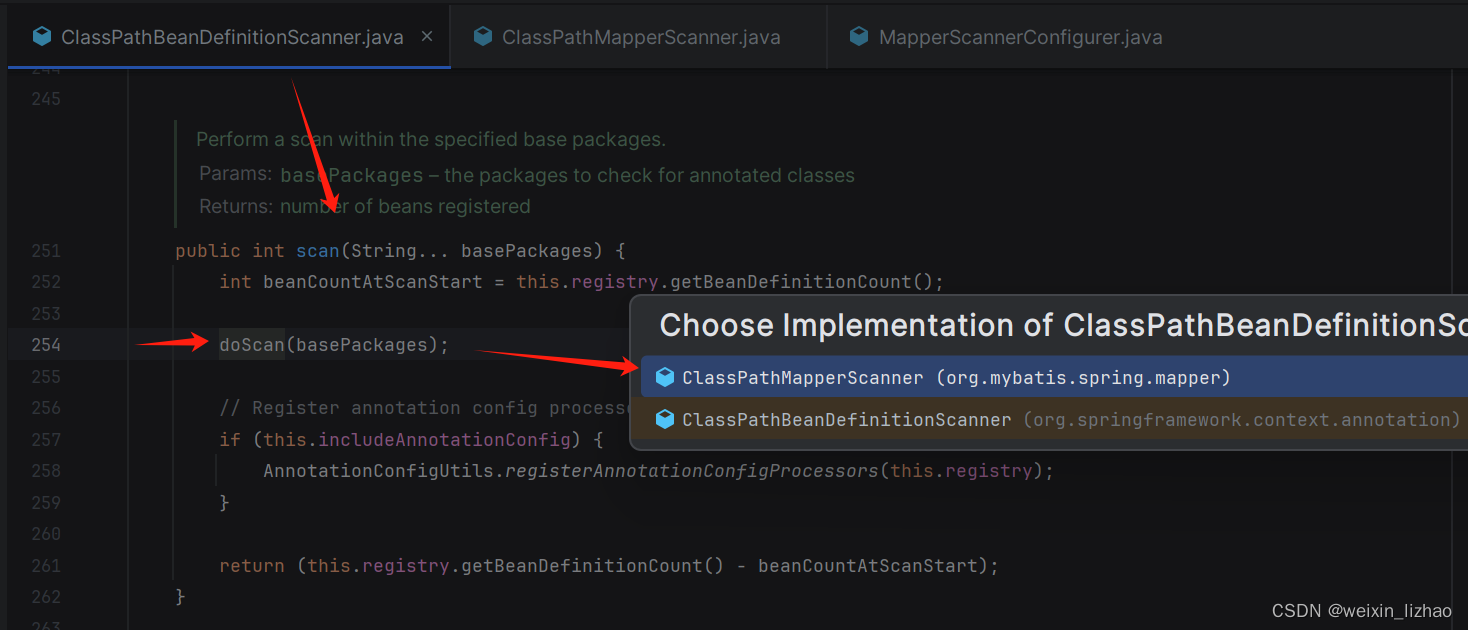
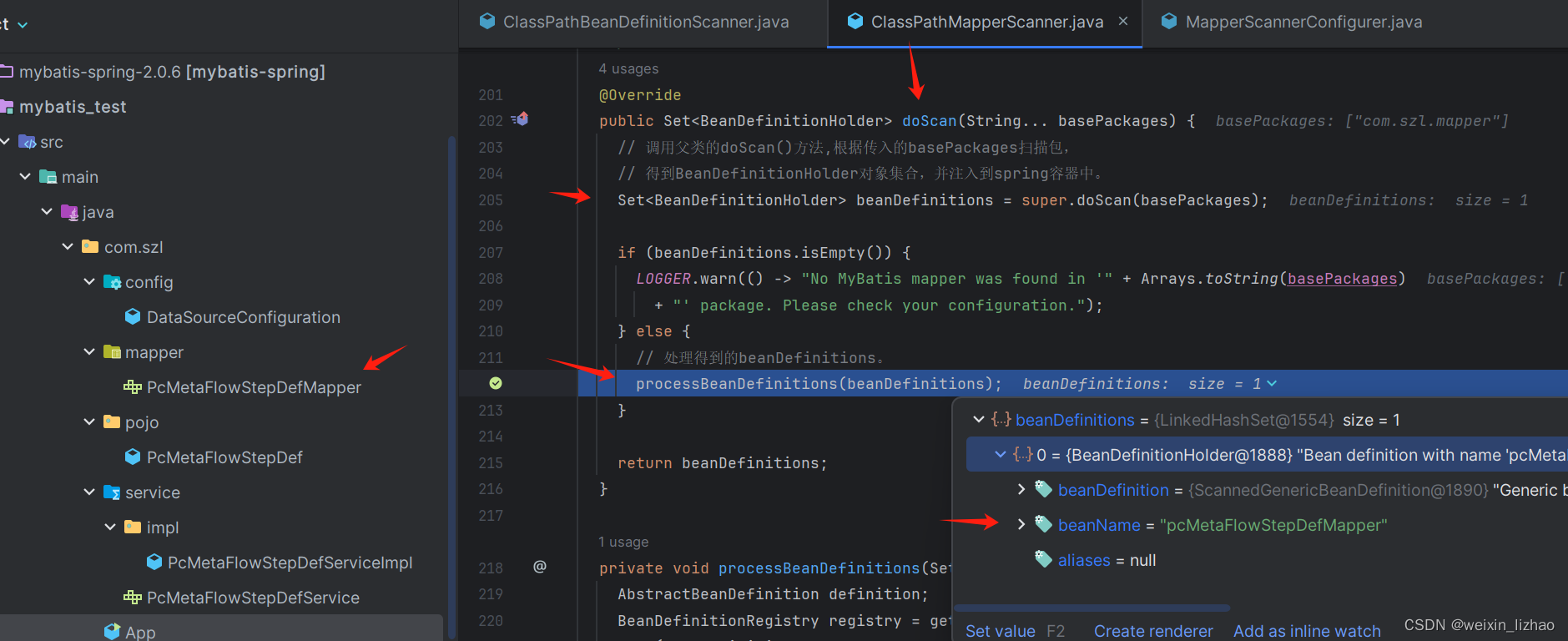
最终调用ClassPathMapperScanner#processBeanDefinitions()方法,代码如下:
private void processBeanDefinitions(Set<BeanDefinitionHolder> beanDefinitions) {
AbstractBeanDefinition definition;
BeanDefinitionRegistry registry = getRegistry();
for (BeanDefinitionHolder holder : beanDefinitions) {
definition = (AbstractBeanDefinition) holder.getBeanDefinition();
boolean scopedProxy = false;
if (ScopedProxyFactoryBean.class.getName().equals(definition.getBeanClassName())) {
definition = (AbstractBeanDefinition) Optional
.ofNullable(((RootBeanDefinition) definition).getDecoratedDefinition())
.map(BeanDefinitionHolder::getBeanDefinition).orElseThrow(() -> new IllegalStateException(
"The target bean definition of scoped proxy bean not found. Root bean definition[" + holder + "]"));
scopedProxy = true;
}
// 获取原始接口的类的全限定名。
String beanClassName = definition.getBeanClassName();
LOGGER.debug(() -> "Creating MapperFactoryBean with name '" + holder.getBeanName() + "' and '" + beanClassName
+ "' mapperInterface");
// the mapper interface is the original class of the bean
// but, the actual class of the bean is MapperFactoryBean
// 设置有参构造的值,在创建bean的时候,就会调用有参构造,传入设置的 beanClassName 作为值创建bean。
definition.getConstructorArgumentValues().addGenericArgumentValue(beanClassName); // issue #59
// 给definition设置新的beanClass。
definition.setBeanClass(this.mapperFactoryBeanClass);
// 创建mapperFactoryBeanClass的时候,进行属性值填充,值就是现在设置的这些...
definition.getPropertyValues().add("addToConfig", this.addToConfig);
// Attribute for MockitoPostProcessor
// https://github.com/mybatis/spring-boot-starter/issues/475
definition.setAttribute(FACTORY_BEAN_OBJECT_TYPE, beanClassName);
boolean explicitFactoryUsed = false;
if (StringUtils.hasText(this.sqlSessionFactoryBeanName)) {
definition.getPropertyValues().add("sqlSessionFactory",
new RuntimeBeanReference(this.sqlSessionFactoryBeanName));
explicitFactoryUsed = true;
} else if (this.sqlSessionFactory != null) {
definition.getPropertyValues().add("sqlSessionFactory", this.sqlSessionFactory);
explicitFactoryUsed = true;
}
if (StringUtils.hasText(this.sqlSessionTemplateBeanName)) {
if (explicitFactoryUsed) {
LOGGER.warn(
() -> "Cannot use both: sqlSessionTemplate and sqlSessionFactory together. sqlSessionFactory is ignored.");
}
definition.getPropertyValues().add("sqlSessionTemplate",
new RuntimeBeanReference(this.sqlSessionTemplateBeanName));
explicitFactoryUsed = true;
} else if (this.sqlSessionTemplate != null) {
if (explicitFactoryUsed) {
LOGGER.warn(
() -> "Cannot use both: sqlSessionTemplate and sqlSessionFactory together. sqlSessionFactory is ignored.");
}
definition.getPropertyValues().add("sqlSessionTemplate", this.sqlSessionTemplate);
explicitFactoryUsed = true;
}
if (!explicitFactoryUsed) {
// 如果 sqlSessionFactory、sqlSessionFactoryBeanName、sqlSessionTemplate、sqlSessionTemplateBeanName
// 都不存在,则设置注入类型为 ByType,在实例化该对象的时候,Spring会通过类型自动装配,注入属性。
LOGGER.debug(() -> "Enabling autowire by type for MapperFactoryBean with name '" + holder.getBeanName() + "'.");
definition.setAutowireMode(AbstractBeanDefinition.AUTOWIRE_BY_TYPE);
}
definition.setLazyInit(lazyInitialization);
if (scopedProxy) {
continue;
}
if (ConfigurableBeanFactory.SCOPE_SINGLETON.equals(definition.getScope()) && defaultScope != null) {
definition.setScope(defaultScope);
}
if (!definition.isSingleton()) {
BeanDefinitionHolder proxyHolder = ScopedProxyUtils.createScopedProxy(holder, registry, true);
if (registry.containsBeanDefinition(proxyHolder.getBeanName())) {
registry.removeBeanDefinition(proxyHolder.getBeanName());
}
registry.registerBeanDefinition(proxyHolder.getBeanName(), proxyHolder.getBeanDefinition());
}
}
}这里就是处理扫描到的所有Mapper接口,该项目只有一个Mapper,即PcMetaFlowStepDefMapper,就被扫锚到了,因此接下来就是怎么处理这个接口了,也就是上面的代码。这里,我只说关键的一点:获取到 BeanDefinition,获取beanClassName,即获取原始接口的类的全限定名,调用 BeanDefinition#getConstructorArgumentValues()#addGenericArgumentValue(beanClassName),后面,会通过构造方法的形式,将beanClassName赋值给某个属性,然后给BeanDefinition设置新的beanClass属性,为 MapperFactoryBean.class,因为接口是无法实例化的,即便接口可以被扫描到,如果不做处理,在实例化的时候还是会报错。其他的属性设置,比较重要的就是设置BeanDefinition的autowireMode属性为 AbstractBeanDefinition.AUTOWIRE_BY_TYPE,也就是使用Spring自己的依赖注入。即Spring会找到所有的Set方法,通过类型进行属性的依赖注入。最后还是调用BeanDefinitionRegistry#registerBeanDefinition()方法,将该BeanDefinition注册到Spring容器中,只不过在实例化的时候,创建的不是Mapper接口,而是MapperFactoryBean对象。再看看 MapperFactoryBean类,很明显它实现了FactoryBean接口,在获取MapperFactoryBean对象的时候,获取的实际上是 MapperFactoryBean#getObject()方法返回的对象。由于MapperFactoryBean还实现了InitializingBean,因此需要先看看 MapperFactoryBean#afterPropertiesSet()方法。类的层级为:

对于实例化方法,需要优先看看,代码如下:
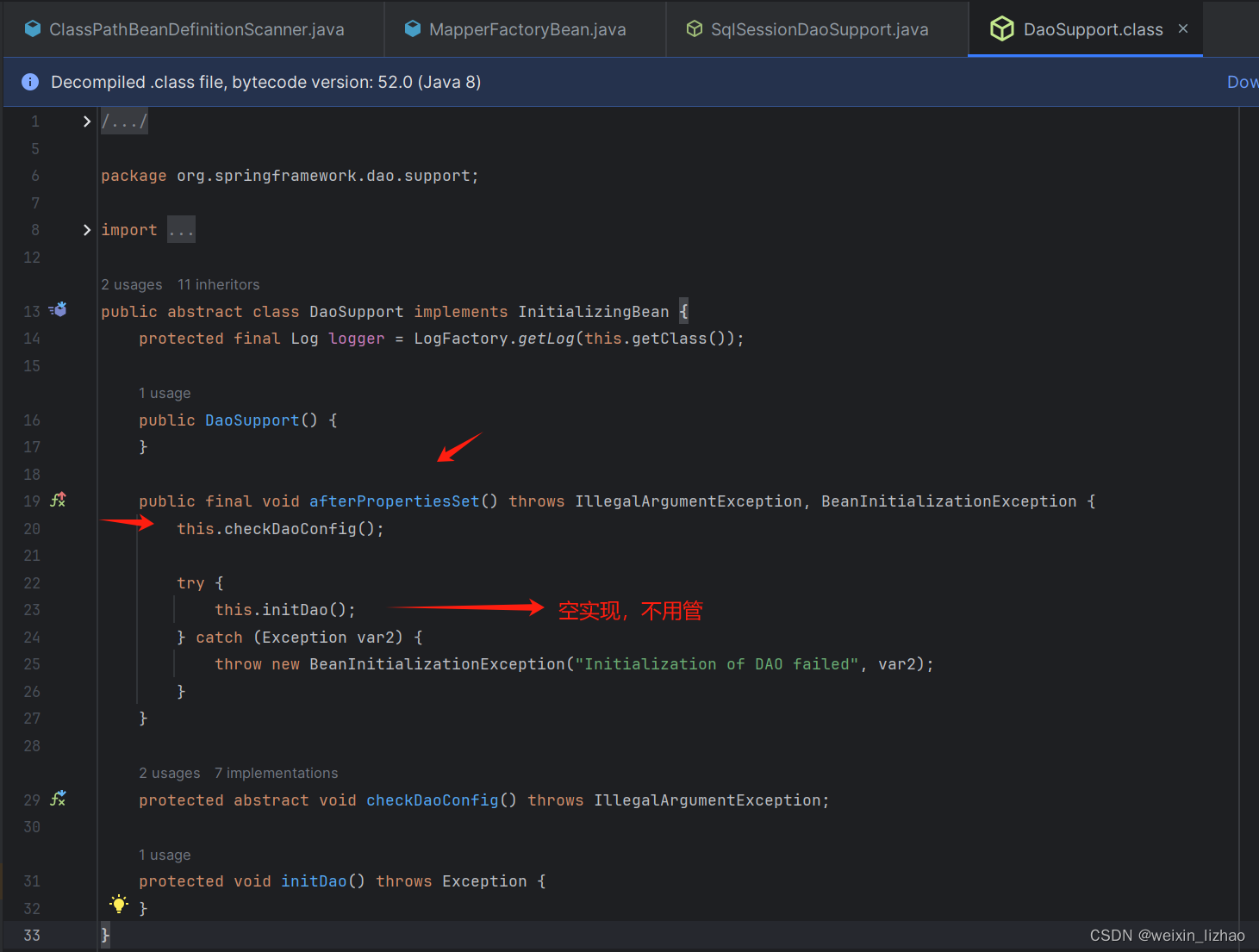

先看看MapperFactoryBean#getSqlSession()方法:
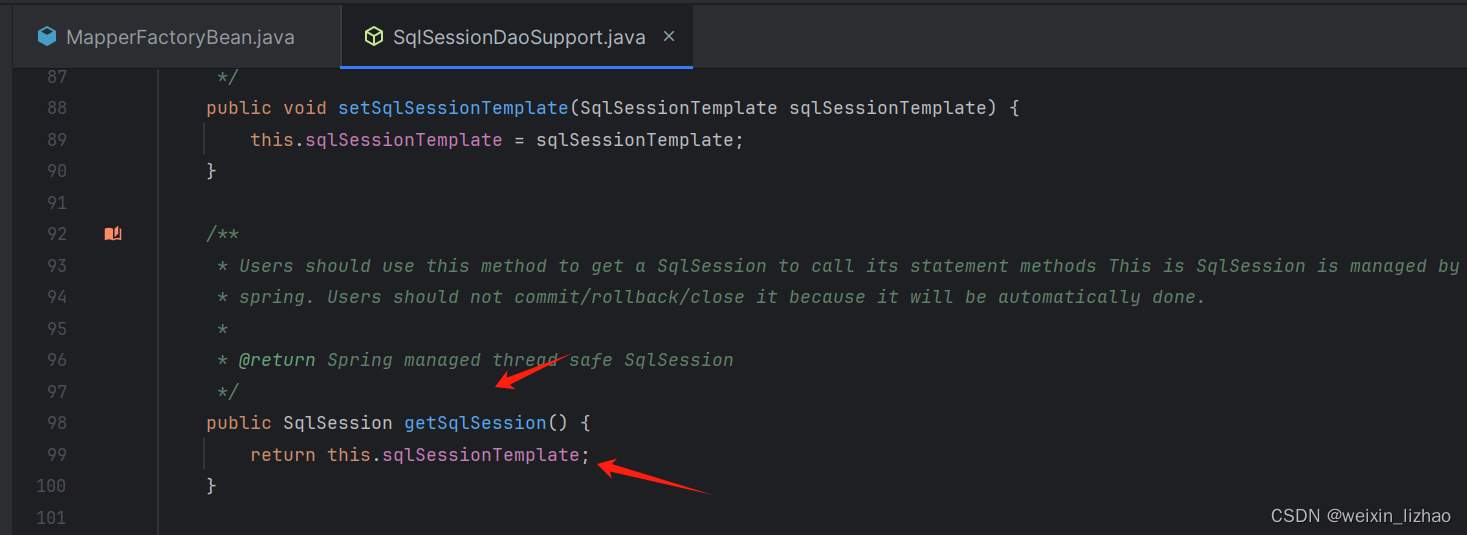
可知是它父类的方法,而父类中sqlSessionTemplate又是拿来的呢?看看是在哪里赋值的就知道了,代码如下:

这里注释讲的很清楚,由于前面给MapperFactoryBean所对应的BeanDefinition对象的autowireMode属性为 AbstractBeanDefinition.AUTOWIRE_BY_TYPE,因此会自动调用SqlSessionDaoSupport#setSqlSessionFactory()方法,进行属性注入。而入参的SqlSessionFactory对象又是哪里来的呢??还记得前面在DataSourceConfiguration配置类中,定义了一个SqlSessionFactoryBean对象吗?实际上就是它,由于它也实现了FactoryBean接口,因此准确的说,应该是SqlSessionFactoryBean#getobject()方法返回的对象,看看该方法,代码如下:


看看SqlSessionFactoryBean#buildSqlSessionFactory()方法,代码如下(截取部分):
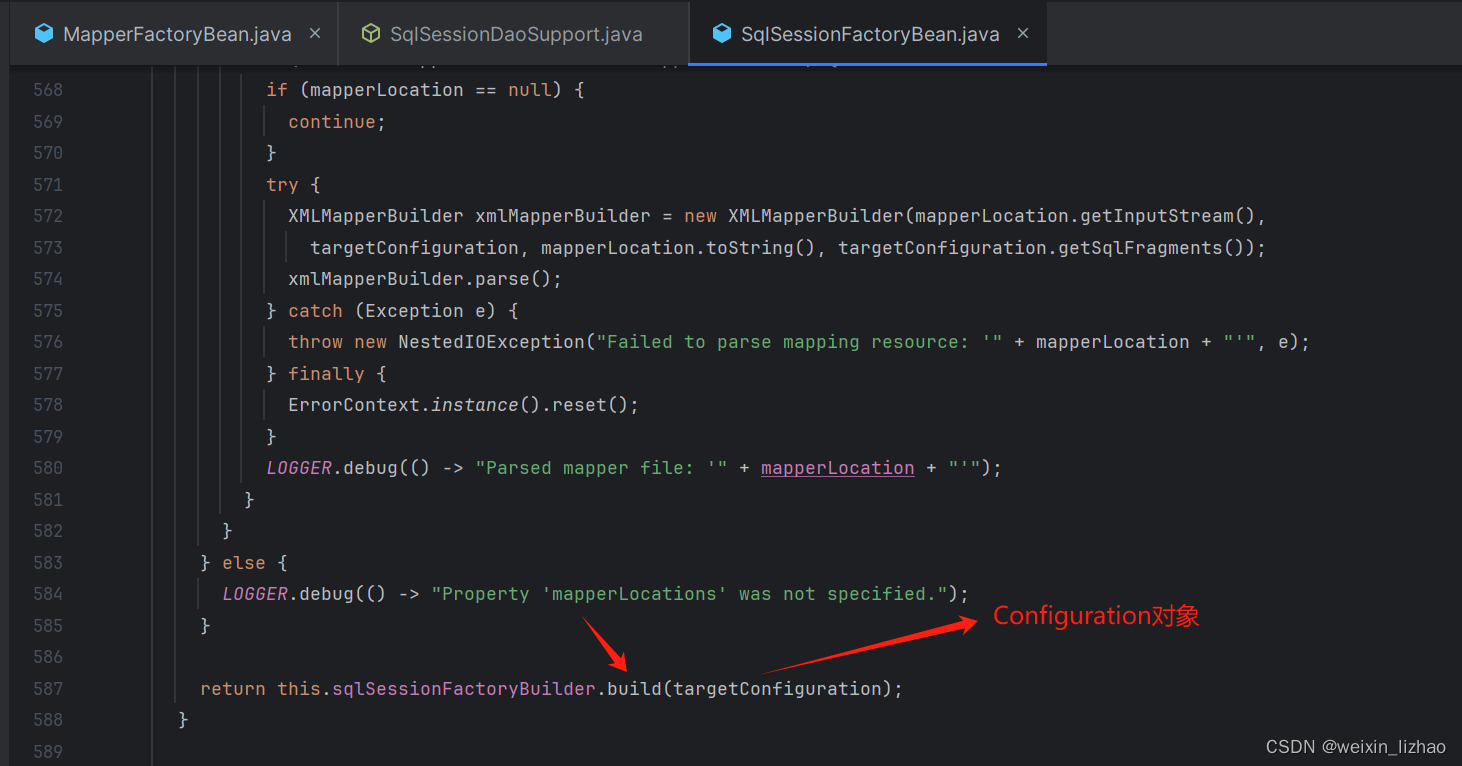

可以知道,最终返回的SqlSessionFactory就是DefaultSqlSessionFactory对象。回到SqlSessionDaoSupport#setSqlSessionFactory()方法,其实传入的SqlSessionFactory,也就是DefaultSqlSessionFactory,由于该方法中,调用了SqlSessionDaoSupport#createSqlSessionTemplate(sqlSessionFactory),代码如下:

创建的对象是SqlSessionTemplate,调用的是有参构造,传入的是DefaultSqlSessionFactory对象。看看该有参构造,代码如下:
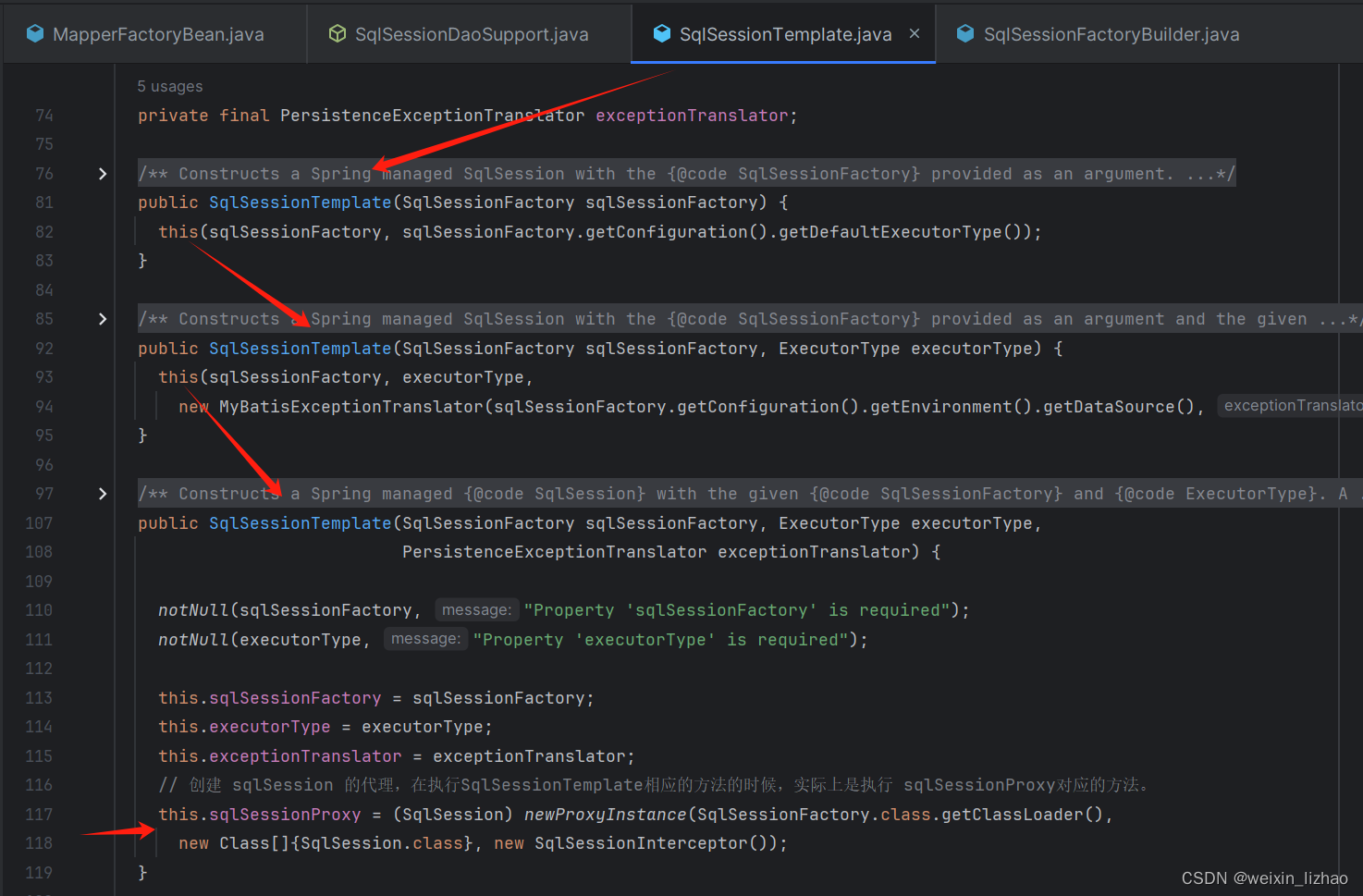
这里最核心的就是,通过JDK的动态代理,给SqlSessionTemplate的sqlSessionProxy进行了赋值。其他的不用看,直接看SqlSessionInterceptor#invoke()方法就好了,代码如下:
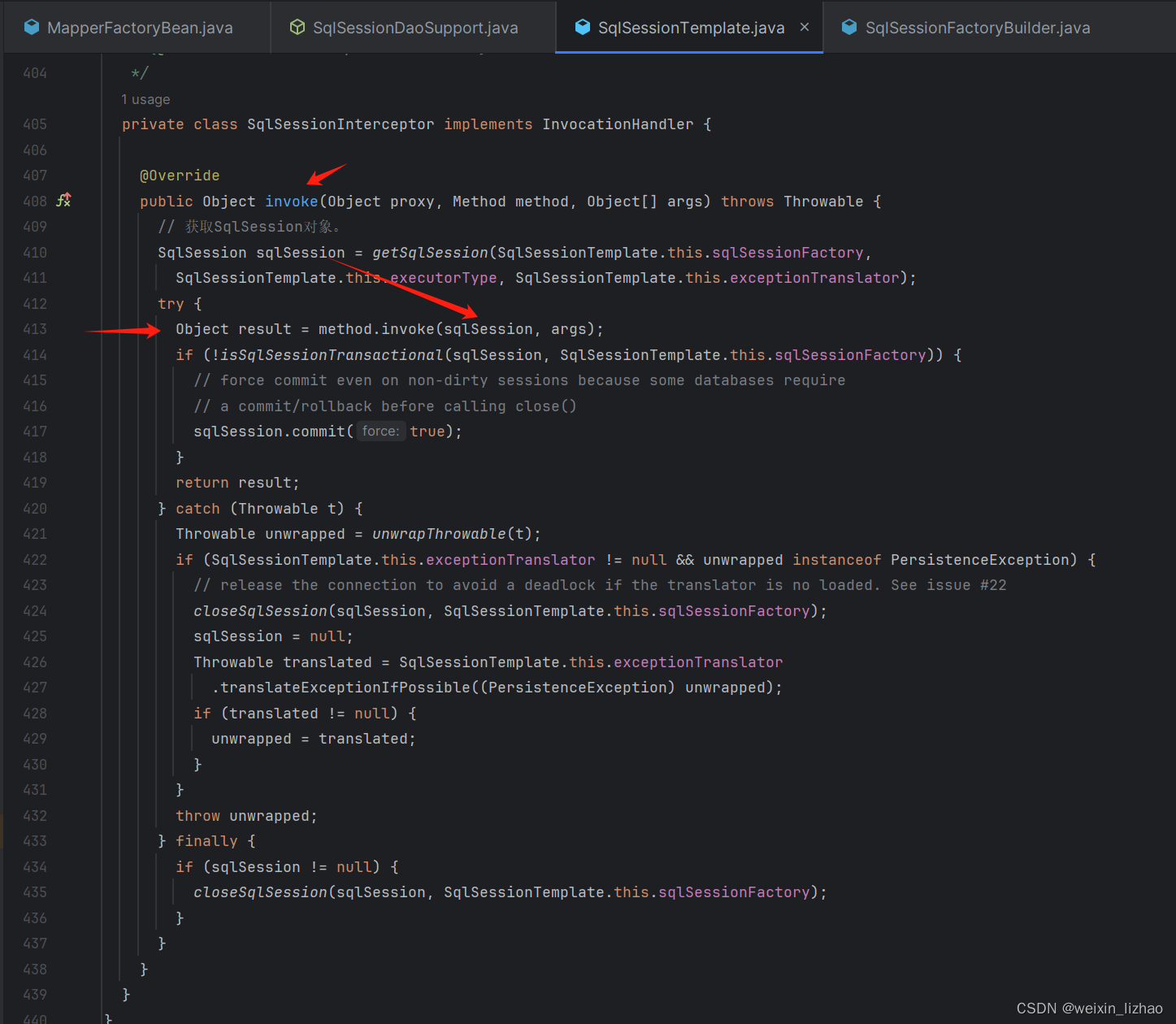
可知,在该方法中,就是先获取了SqlSession对象,通过反射,调用SqlSession中的某些方法,先记住这里,后面会说到。ok,回到MapperFactoryBean#checkDaoConfig()方法,代码如下:
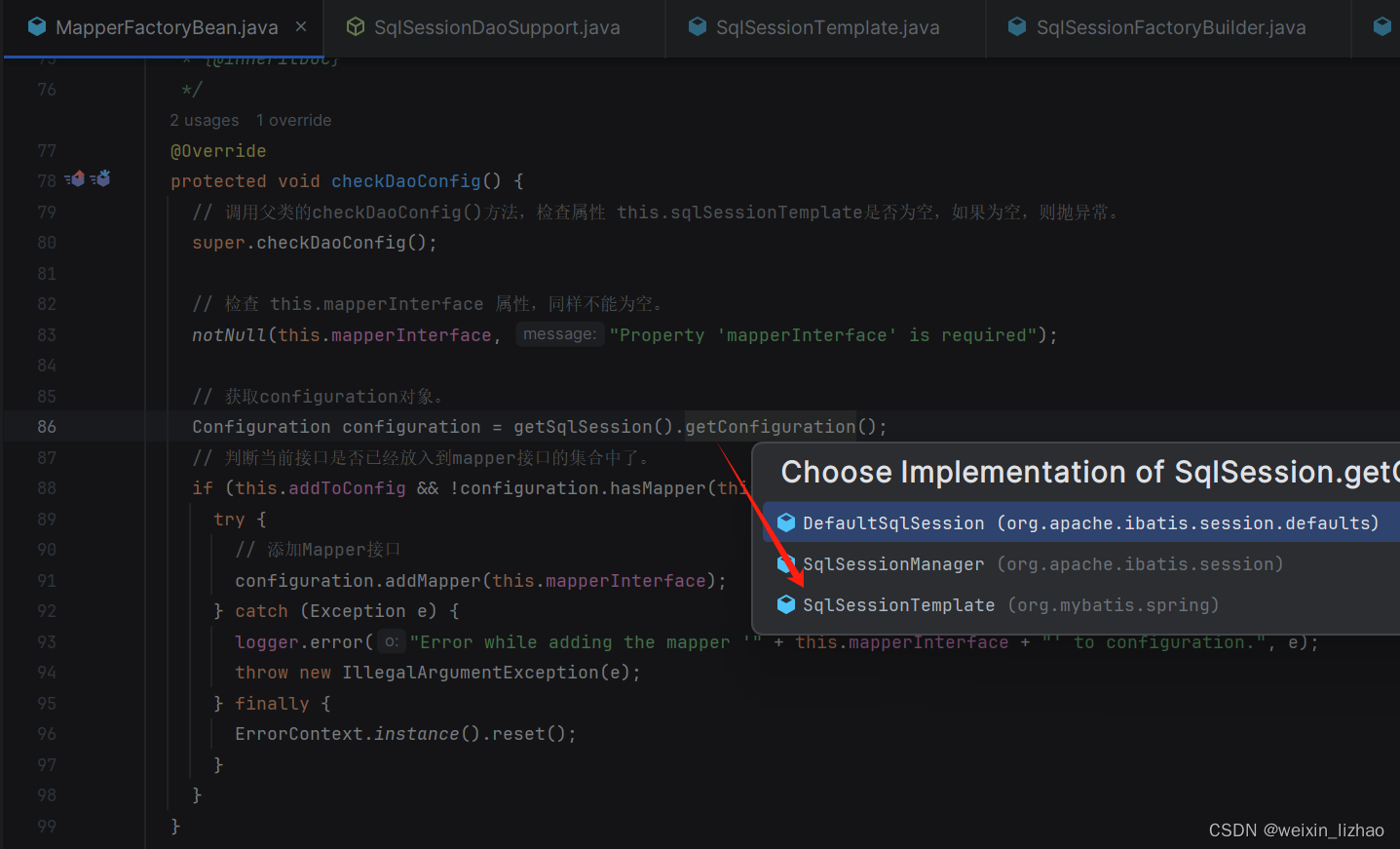

就是获取SqlSession对象,也就是SqlSessionTemplate对象,最终就是从DefaultSqlSessionFactory对象中,获取到Configuration对象,然后调用Configuration#addMapper()方法,传入Mqpper接口,即项目中的PcMetaFlowStepDefMapper.class。看看该方法,代码如下:

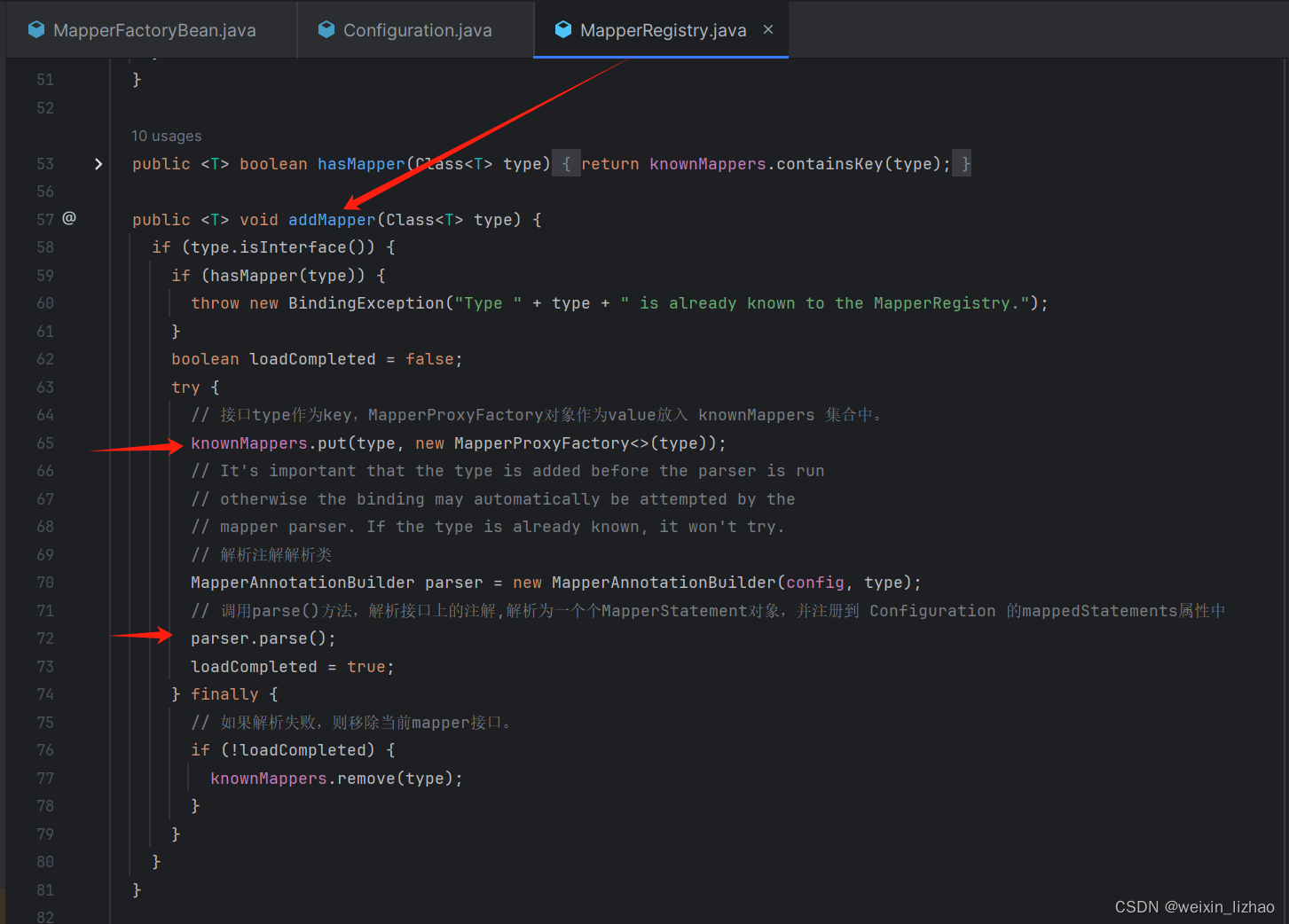
可知,会创建 MapperProxyFactory对象,调用有参构造,传入Mapper接口,并且将其放入
knownMappers中,key为Mapper接口,value为 MapperProxyFactory对象。再构建MapperAnnotationBuilder对象,调用MapperAnnotationBuilder#parse()方法,解析Mapper接口中是否有以下注解:@SelectProvider、@ResultMap、@Select、@Update、@Insert、@Delete,有则处理,代码如下:
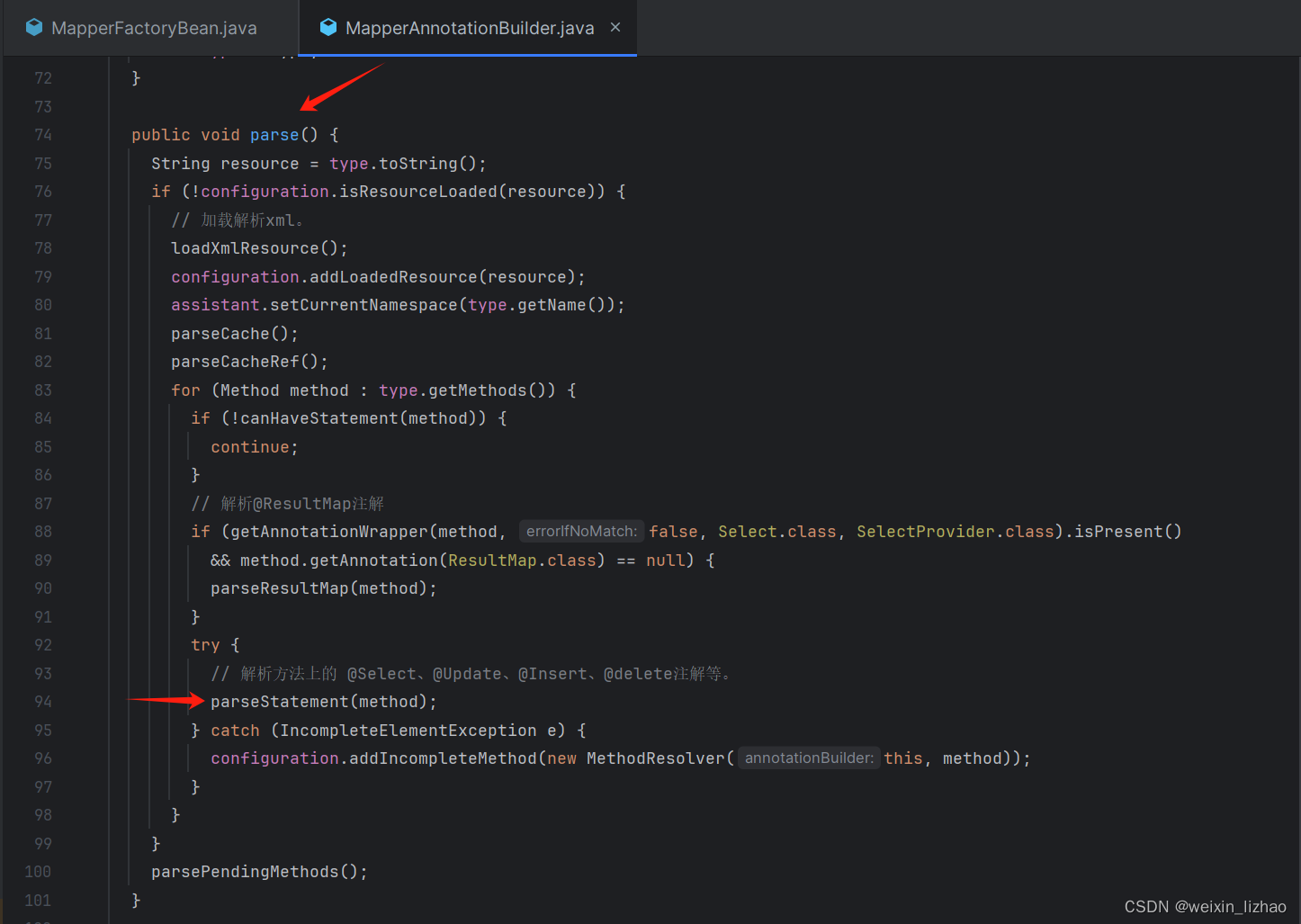
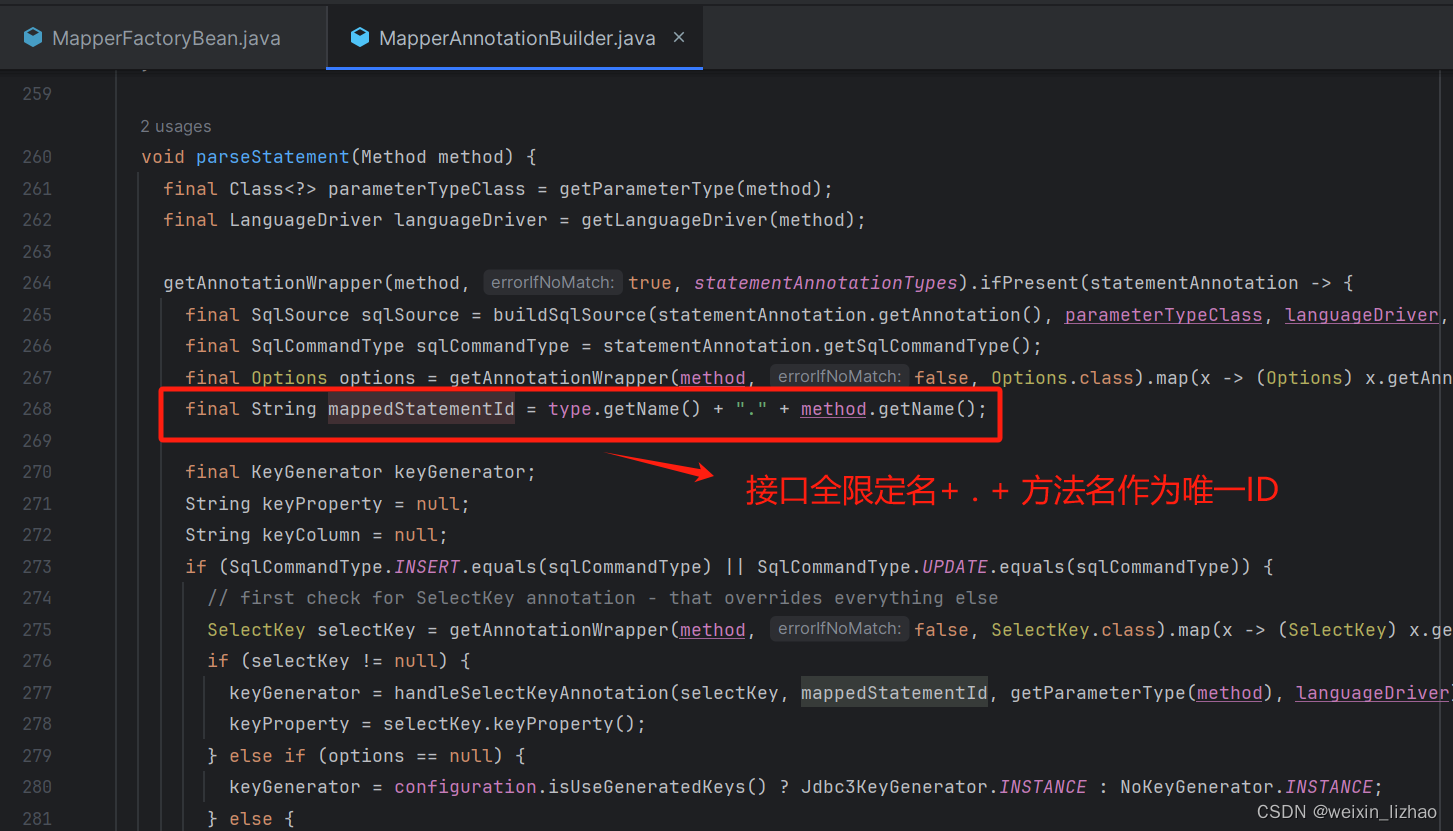
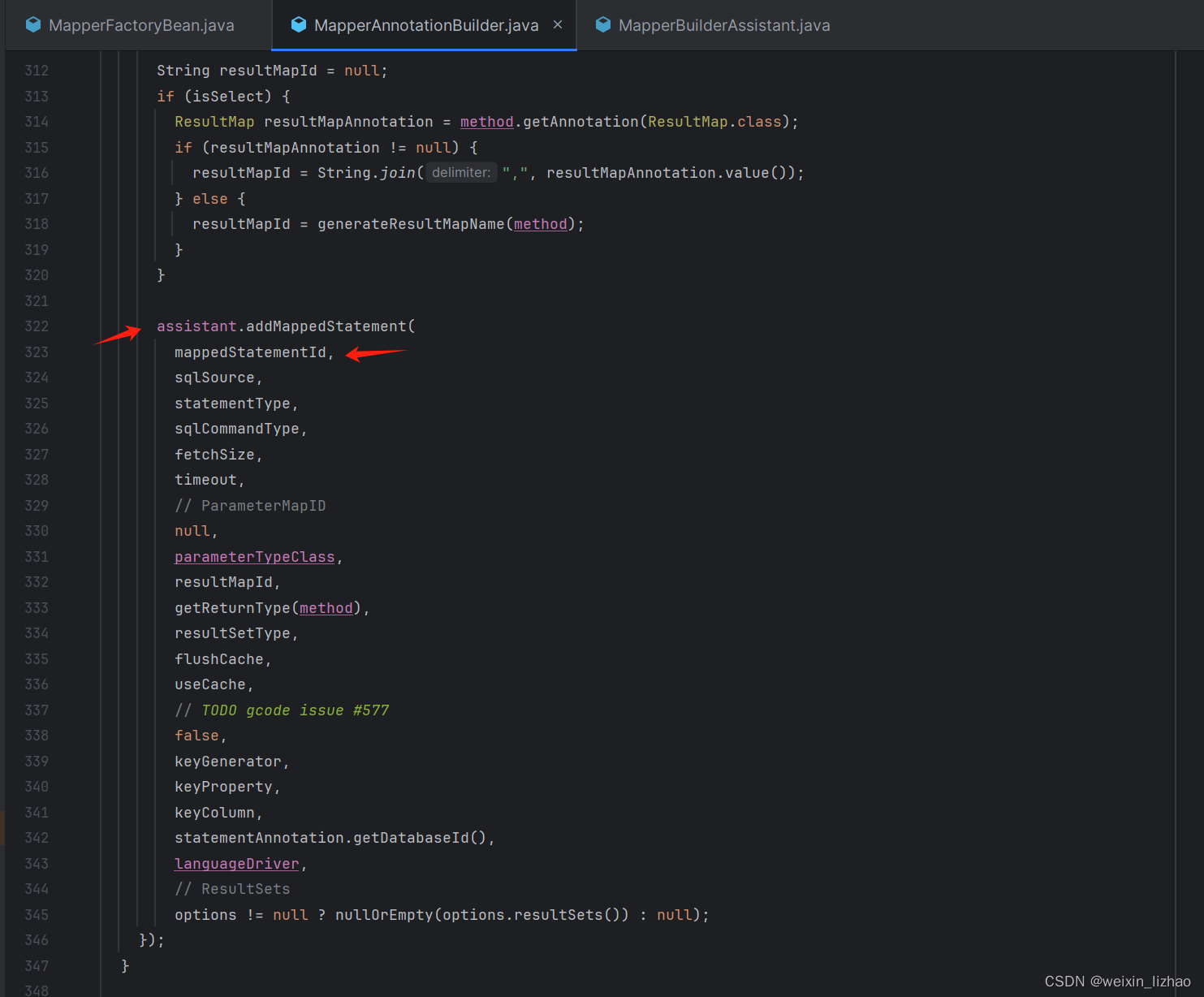
到这里为止,扫描到的Mapper接口被成功加入到了Spring容器,只不过真正的生成的对象是MapperFactoryBean罢了,并且对mapper接口中的注解扫描也完成的,被上述注解修饰的方法,会生成一个MappedStatement,缓存起来,想要获取MappedStatement,通过Mapper接口的全限定名+"."+方法名就可以获取到,如果Mapper接口中有两个重载方法会报错!
这时候,我们可以想一个场景,假设在一个Service类中,通过@Autowired依赖了这个Mapper接口,由于这个接口在Spring容器中是对应的bean是MapperFactoryBean,因此在真正进行注入的时候,注入的Mapper对象是 MapperFactoryBean#getobject()方法返回的对象,代码如下:
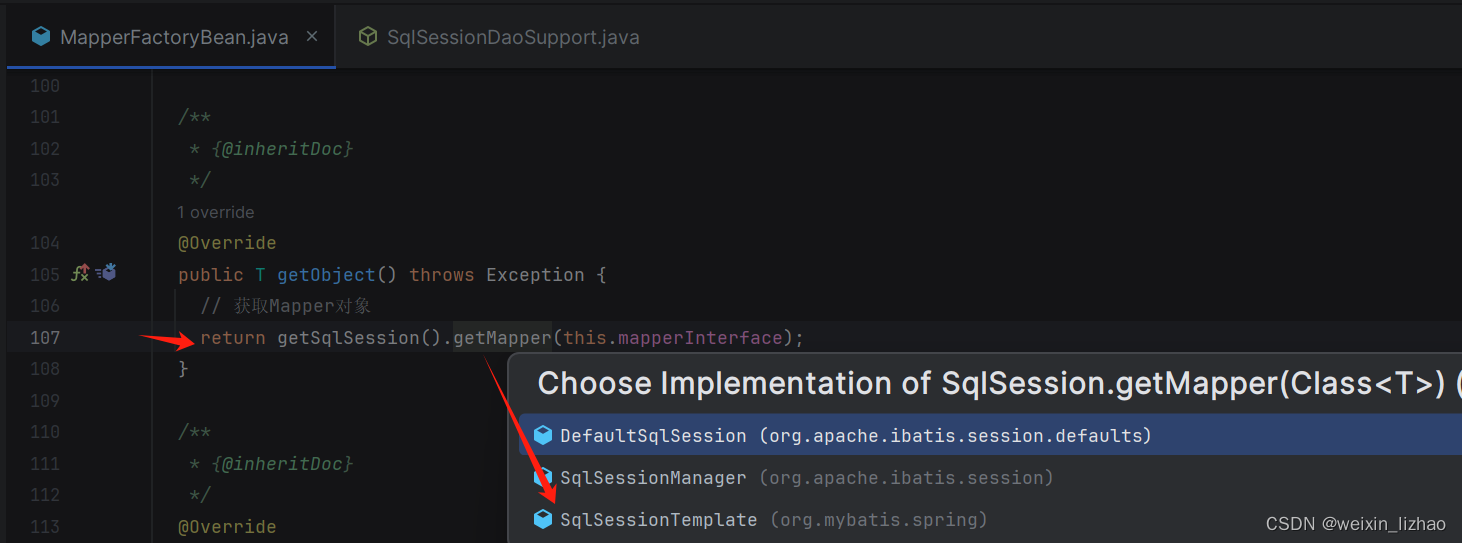


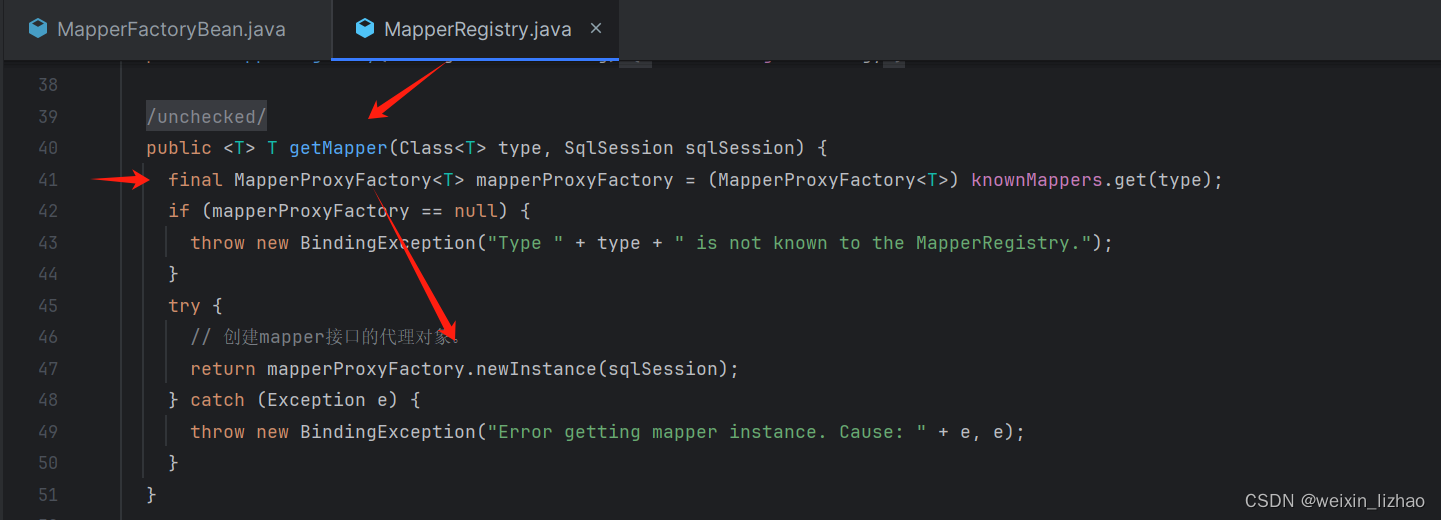

可知,最终生成的Mapper就是通过JDK生成的代理对象,而这个代理对象那个,传入的InvocationHandler,就是MapperProxy,MapperProxy#invoke()方法即可,代码如下:
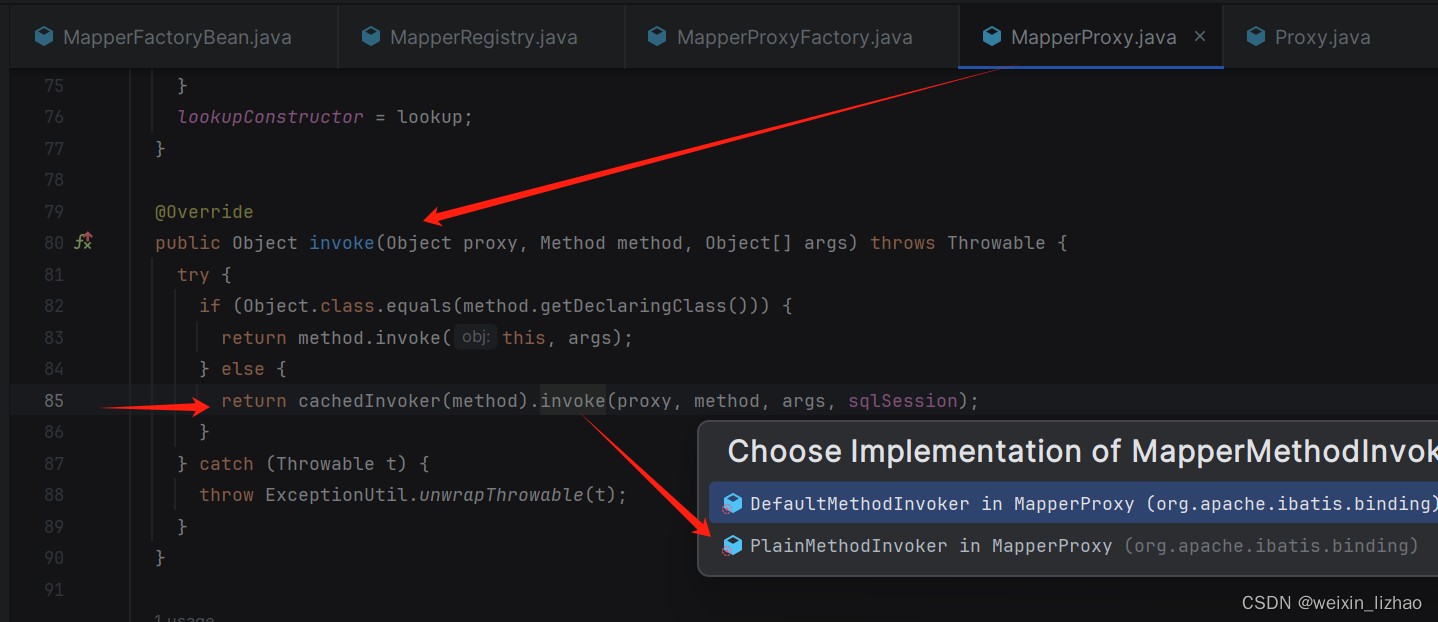
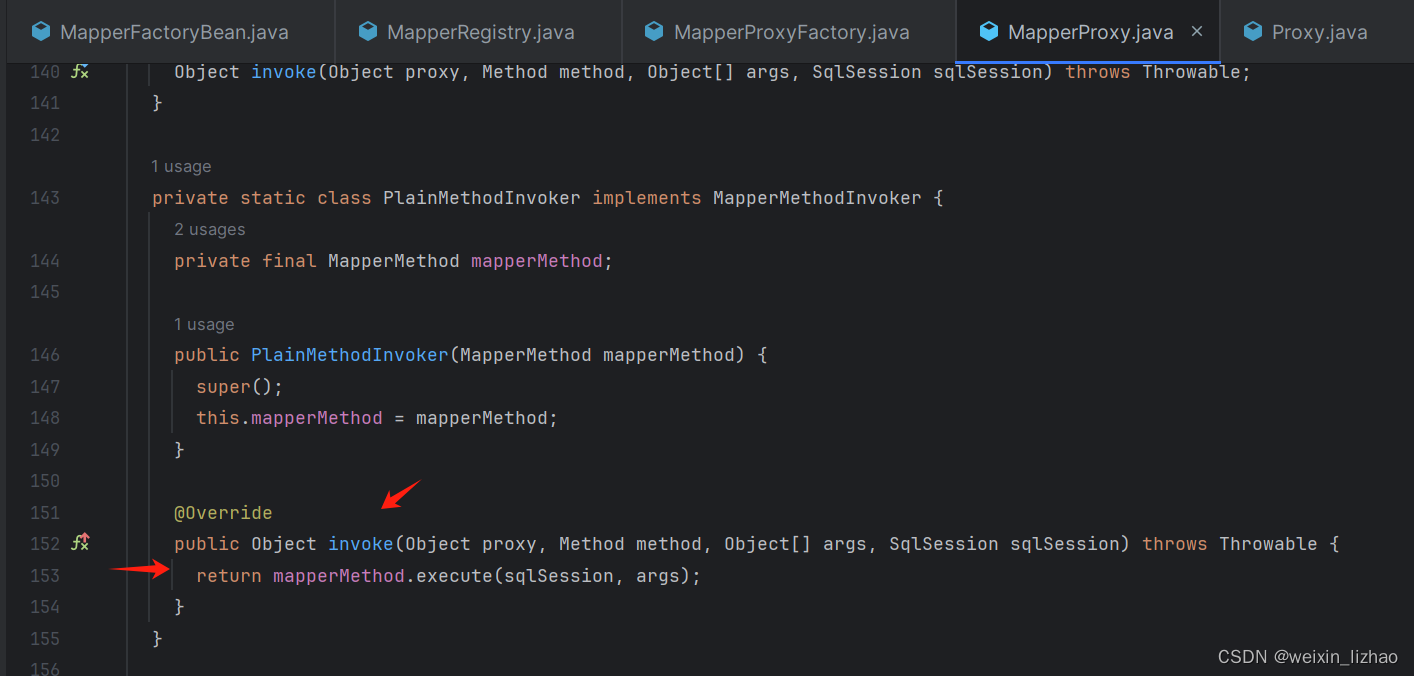
public Object execute(SqlSession sqlSession, Object[] args) {
// 判断 command 的类型。
Object result;
switch (command.getType()) {
case INSERT: {
Object param = method.convertArgsToSqlCommandParam(args);
result = rowCountResult(sqlSession.insert(command.getName(), param));
break;
}
case UPDATE: {
Object param = method.convertArgsToSqlCommandParam(args);
result = rowCountResult(sqlSession.update(command.getName(), param));
break;
}
case DELETE: {
Object param = method.convertArgsToSqlCommandParam(args);
result = rowCountResult(sqlSession.delete(command.getName(), param));
break;
}
case SELECT:
if (method.returnsVoid() && method.hasResultHandler()) {
executeWithResultHandler(sqlSession, args);
result = null;
} else if (method.returnsMany()) {
result = executeForMany(sqlSession, args);
} else if (method.returnsMap()) {
result = executeForMap(sqlSession, args);
} else if (method.returnsCursor()) {
result = executeForCursor(sqlSession, args);
} else {
Object param = method.convertArgsToSqlCommandParam(args);
result = sqlSession.selectOne(command.getName(), param);
if (method.returnsOptional()
&& (result == null || !method.getReturnType().equals(result.getClass()))) {
result = Optional.ofNullable(result);
}
}
break;
case FLUSH:
result = sqlSession.flushStatements();
break;
default:
throw new BindingException("Unknown execution method for: " + command.getName());
}
if (result == null && method.getReturnType().isPrimitive() && !method.returnsVoid()) {
throw new BindingException("Mapper method '" + command.getName()
+ " attempted to return null from a method with a primitive return type (" + method.getReturnType() + ").");
}
return result;
}这里以查询为例,查询的方法当然是被@Select注解所修饰了,执行的应该是这里的代码:
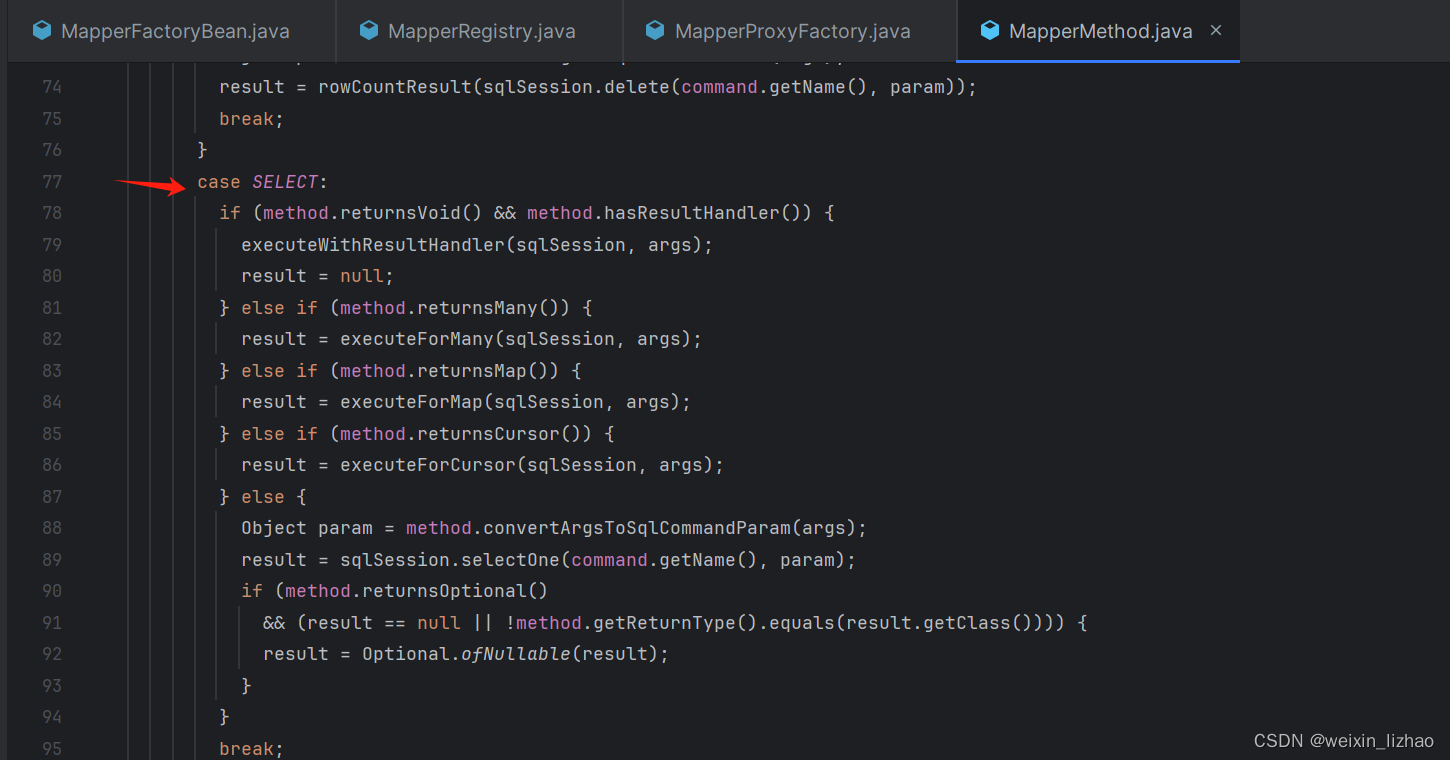
真正调用具体方法的实惠,会先判断查询方法的返回值,返回的是返回的是Map呢?还是List呢?这里以List为例,则调用的是MapperMethod#executeForMany()方法了,代码如下:
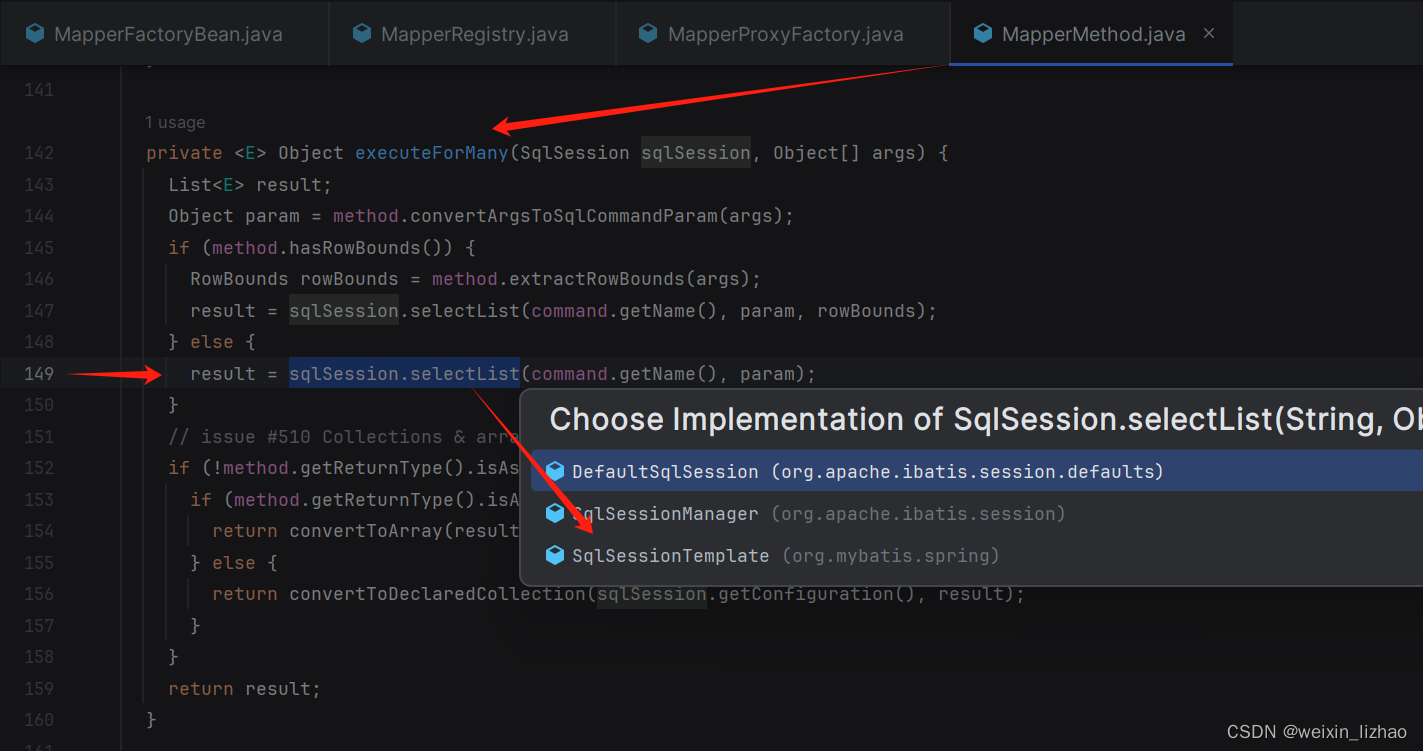
核心就是调用SqlSession#selectList()方法,而这里的SqlSession当然就是SqlSessionTemplate了,该方法的代码如下:

这里的sqlSessionProxy对象我在前面讲过了,他是通过JDK的动态代理生成的代理对象,因此只需要看,SqlSessionInterceptor#invoke()方法即可,代码如下:
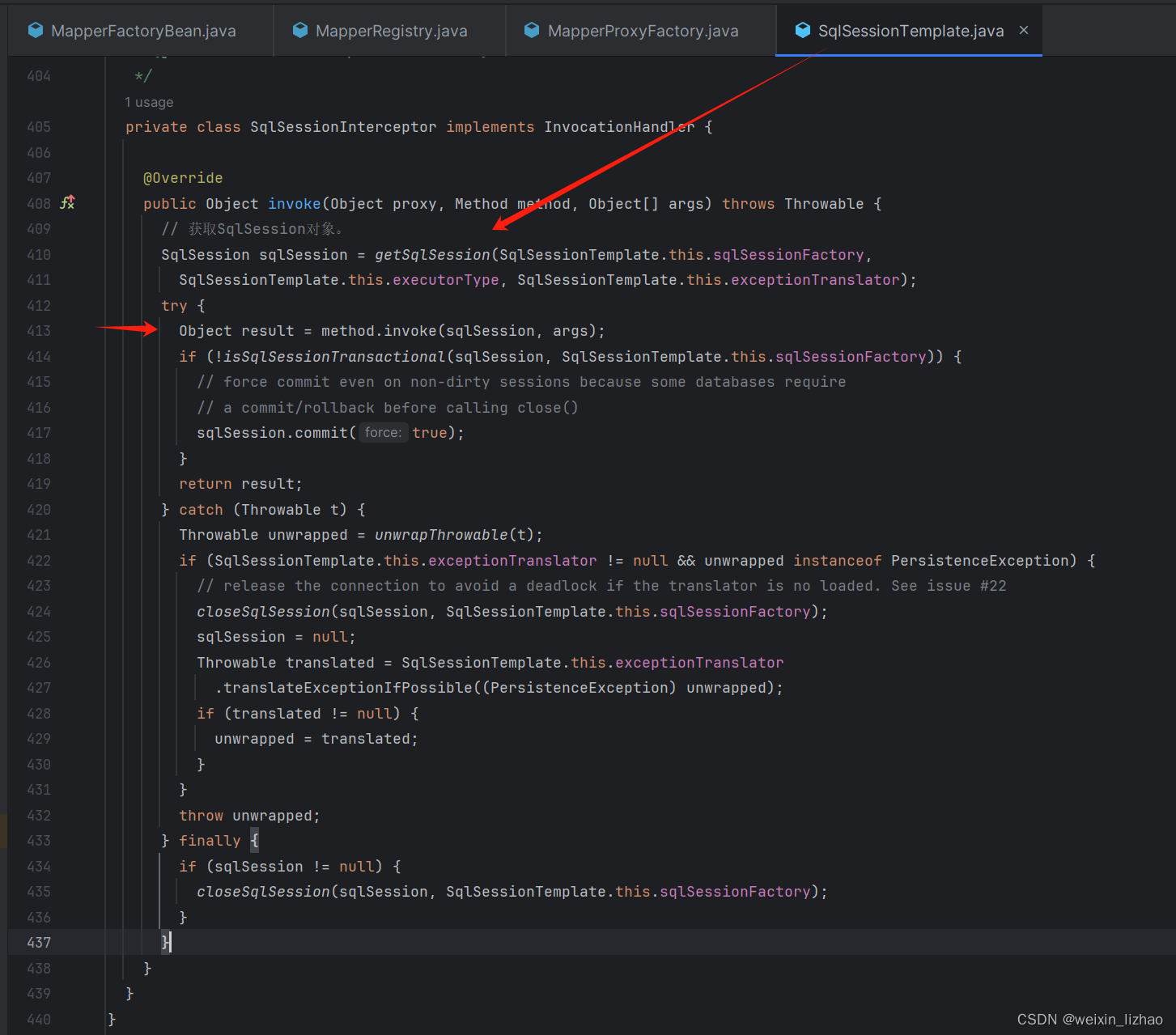
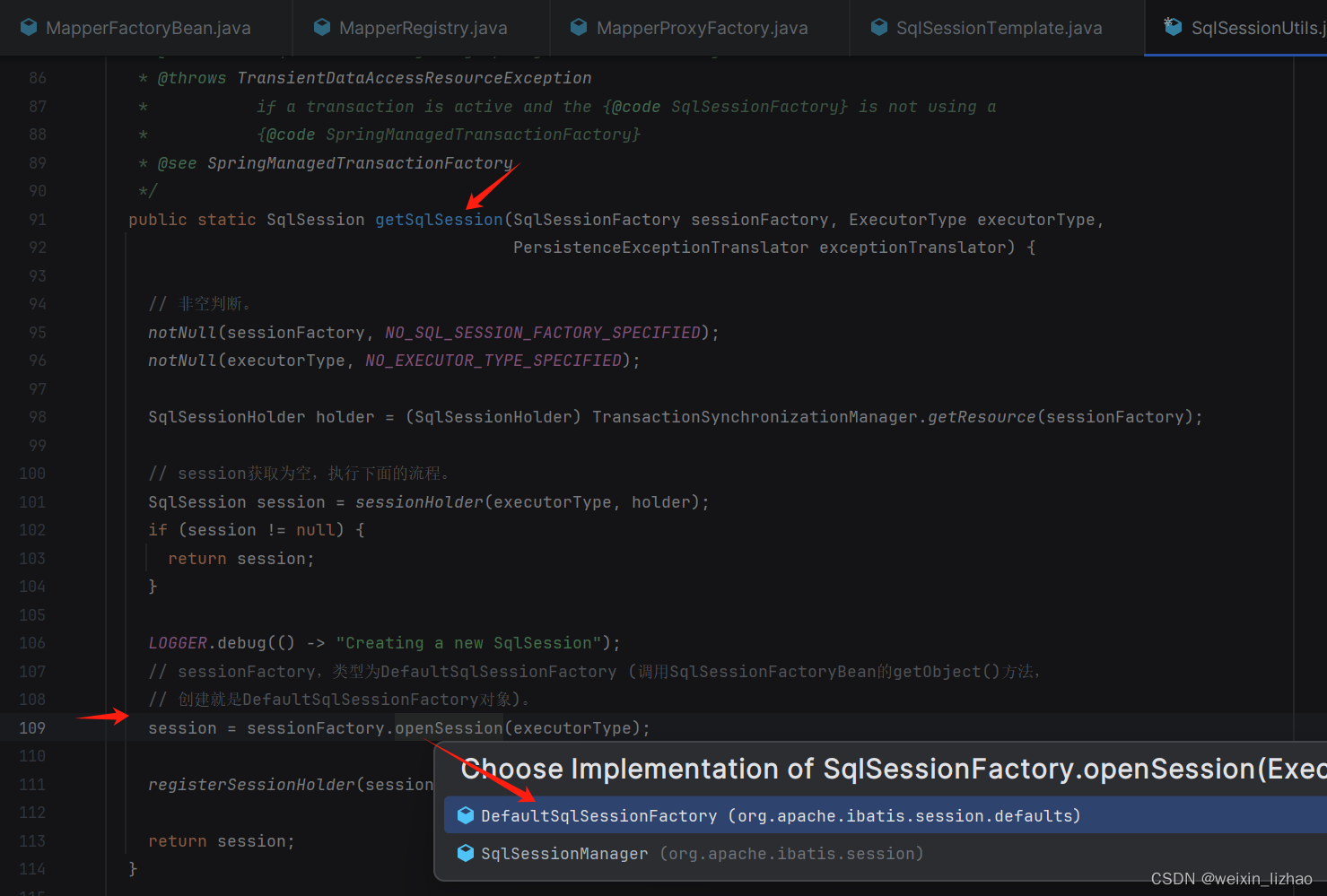



这里实际上是通过反射,调用 DefaultSqlSession#selectList(),方法如下:
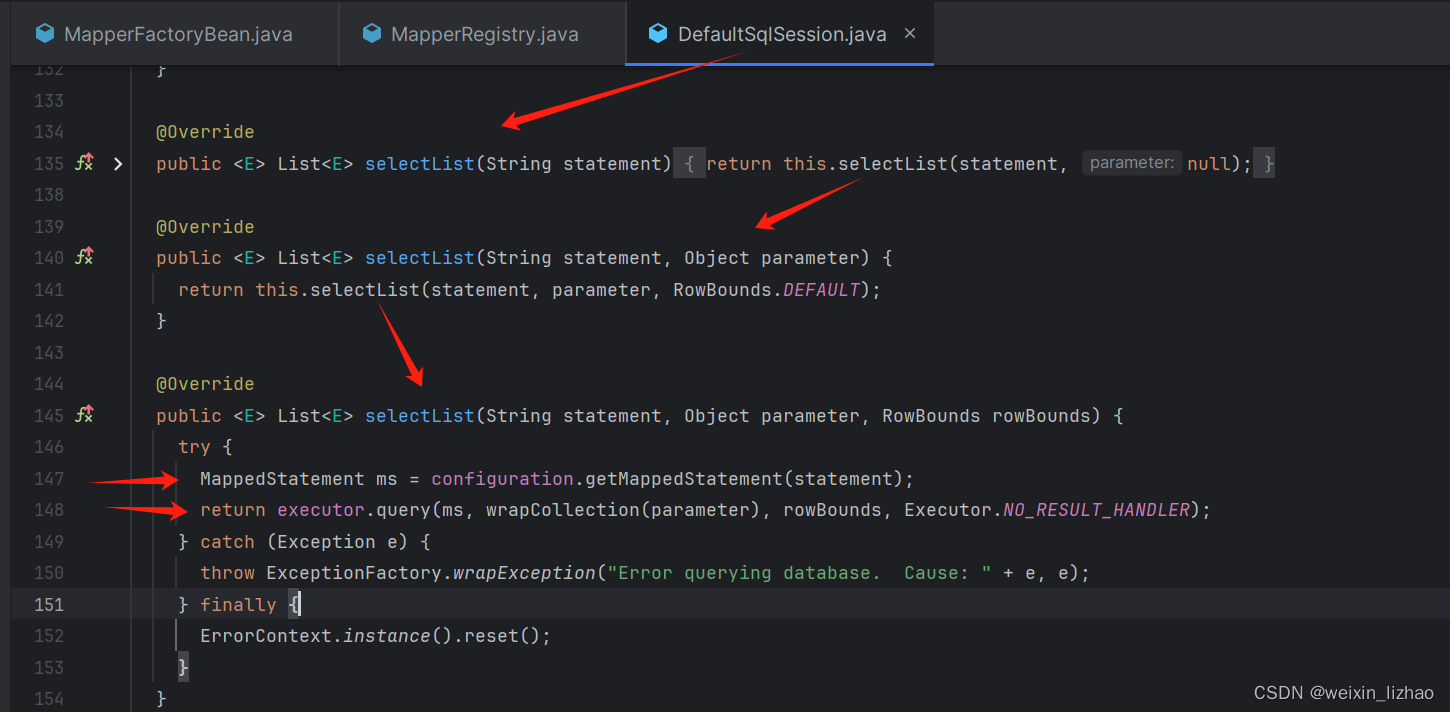
到这里为止,其实Mybatis的核心调用逻辑就讲完了。剩下的内容,请移步到这里:Mybatis整合Spring事务原理&数据库连接池原理讲解





















 236
236

 被折叠的 条评论
为什么被折叠?
被折叠的 条评论
为什么被折叠?








